
20
Jun
(Beyond Pesticides June 20, 2016) As the end of the school year approaches, two first grade classrooms at local District of Columbia Public Schools (DCPS) got to learn about the importance of pollinators firsthand when DC-based nonprofit Beyond Pesticides visited their school. In a lead up to National Pollinator Week, Beyond Pesticides teamed up with owner and founder of The Bees Waggle, Jessica Goldstrohm, to provide a fun, hands-on lesson about pollination, and why it is important to our food system. Students were given a lesson on biodiversity, soil health, and the negative effects of pesticides on pollinators before building some pollinator-friendly habitat for their schools and homes.
The day of learning kicked off at Brightwood Education Campus, located in Northwest DC, where students listened to a lesson developed by Ms. Goldstrohm, who donned a set of bee wings for the event. After receiving some background on the role of pollinators in our food system, the children participated in several hands on activities that reiterated the key points within the curriculum. Six volunteers stepped to the front of the class to demonstrate the interconnectedness of all living organisms by participating in a biodiversity web simulation. Here, the scholars learned that if one organism in a food system starts to take more than its fair share of resources, the rest of the web find itself out of balance. At the end of the lesson, students each crafted their own small ‚Äúbee hotel‚ÄĚ before heading outside to plant a butterfly box in their garden.
This box will serve as nesting habitat for migrating butterflies, including the monarch, which have experienced rapid population declines over recent years. Loss of habitat around  genetically engineered (GE) cropland, as well as increasingly warm temperatures are responsible for these declines, according to scientists who say populations are the lowest they have seen in two decades. Additionally, in 2015 new research from the University of Minnesota presented some of the first evidence linking the bee-killing insecticides known as neonicotinoids to monarch butterfly deaths. The study found that milkweed plants, which monarch butterflies need to survive, may also retain neonicotinoids from nearby plants, making milkweed toxic to monarchs.
Later in the day, the educational team moved to Northwest DC where they visited first grade scholars at J.O. Wilson Elementary School. Here the children received a similar lesson, this time dividing into groups to apply the information they had learned to solve puzzles about food systems. Working as a team, the students had to figure out how to place several pictures in an order that would represent how a food system worked from start to finish. For example, one puzzle began with a bee, who then pollinated clover seeds, allowing that clover to grow and be fed on by a cow, who eventually provided milk for humans to drink. The children enjoyed using their critical thinking skills to figure out the role of pollinators in providing food, and used that knowledge to draw connections between pollinators and themselves.
The visit to J.O. Wilson was highlighted by the building of a large bee hotel for the school garden. Bee hotels provide natural habitat for native bees, such as the leafcutter and mason bee. These bees are known as ‚Äúsolitary bees‚ÄĚ because they make individual nest cells for their larvae, as opposed to living in colonies like the honeybee. They typically nest in small holes or tunnels, and so Beyond Pesticides staff created a hotel structure into which the students placed pieces of wood with holes in them for the bees to use as nesting sites. The class worked together to create a welcoming habitat for native pollinators, and even got to help hammer on the protective screens, which was a huge hit (pun intended). The hotel found a permanent home in the school‚Äôs fruit and vegetable garden, where it will help facilitate the pollination of those plants for years to come.
Educating local school children is just one of the many ways Beyond Pesticides is honoring pollinators this month. With National Pollinator Week kicking off today, there are several other events throughout the week designed to promote the work Beyond Pesticides does to protect pollinator health and combat their declines. See below for several ways you can get involved.
National Pollinator Week Events
1) Support Pollinators and D.C. Restaurants through ¬†the ‘Made By ¬†Pollinators’ Campaign.
With one out of every three bites of food reliant on bees, restaurants participating in the ‘Made By Pollinators‘ campaign have created a special menu featuring pollinator-friendly food and will be providing customers with information on what they can do to help pollinators. The restaurants hope to increase public awareness on the importance of pollinators and steps that can be taken to reverse the decline.
Participating  restaurants include Busboys and Poets, Founding Farmers, Lavagna, the Tabard Inn and Restaurant Nora. Have a great meal and save the bees!
Find out more by checking out our ‘Made By Pollinators’ Facebook Event Page!
2) Attend the *FREE* ‘Made By Pollinators’ Event at Busboys and Poets at 5th & K!
Join Beyond Pesticides and our beekeeping allies and experts from the Keep the Hives Alive tour for a National Pollinator Week event focused on declining pollinator populations and the impact of their loss on our food system, with video screening and discussion. The event takes place at Busboys and Poets on 5th and K St NW on Wednesday night, June 22nd from 6:30pm to 8:00pm.
Let us know if you’ll be attending. Please RSVP on Facebook.
3) Help ‘Keep the Hives Alive‚Äô
On Wednesday, June 22nd at 1:30 pm in front of EPA HQ, Beyond Pesticides and our allies will be calling on EPA to take immediate action on harmful uses of toxic pesticides to protect bees, butterflies, birds, bats and other pollinators as well as farmers, beekeepers, farmworkers, and consumers.
The rally will be the last stop on the Keep the Hives Alive tour, and will feature local, regional, and national speakers, including beekeepers from across the country, and local progressive business leaders ¬†Nora Pouillon of Restaurant Nora’s and Scott Nash of ¬†MOM’s Organic Market.
At the rally, we’ll deliver sealed containers of dead bees to EPA, making it clear that we need immediate action to save these essential pollinators.
If you haven’t yet, please sign our petition to EPA today!
4) Attend the USDA Pollinator Festival!
Beyond Pesticides will be tabling at USDA’s National Pollinator Festival on Friday June 24th, from 10:00 am to 2:00 pm. The festival is held outside USDA Headquarters next to the Headquarters People‚Äôs Garden and the USDA Farmers Market along 12th Street, SW in Washington, DC 20250.
The curriculum developed by Ms. Goldstrohm in partnership with Beyond Pesticides will be available this fall on the Beyond Pesticides website. Additional information, including exciting grant opportunities for your school, will also be available at that time.
For more information on what you can do to protect pollinators, see  www.beeprotective.org.
 All unattributed positions and opinions in this piece are those of Beyond Pesticides.
Posted in Announcements, Children/Schools, Habitat Protection, Pollinators, State/Local, Take Action, Washington D.C. by: Beyond Pesticides
1 Comment
17
Jun
(Beyond Pesticides, June 17, 2016) The pesticide industry has weakened and delayed pesticide reforms and is shaping new state pollinator ‚Äúprotection‚ÄĚ plans nationwide that do little to protect bees, according to a new Friends of the Earth report. ¬†The report is being released in advance of ¬†Pollinator Week (June 20-26, 2016), as people assemble to ask for improved protection for pollinators.
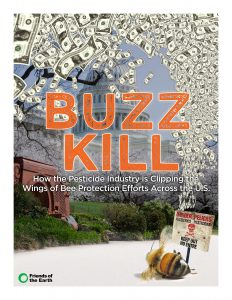 The investigation, Buzz Kill: How the Pesticide Industry is Clipping the Wings of Bee Protection Efforts Across the U.S., reveals an array of pesticide industry tactics to slow urgently needed pollinator protection measures at federal and state levels. The report details how new state pollinator protection plans, many still unfinished, have been heavily influenced by pesticide industry interests. According to the report, industry is spending hundreds of thousands of dollars on lobbying to delay state and federal action on the chemicals they manufacture. As a result, state pollinator protection plans across the U.S. are falling short in several ways, including:
The investigation, Buzz Kill: How the Pesticide Industry is Clipping the Wings of Bee Protection Efforts Across the U.S., reveals an array of pesticide industry tactics to slow urgently needed pollinator protection measures at federal and state levels. The report details how new state pollinator protection plans, many still unfinished, have been heavily influenced by pesticide industry interests. According to the report, industry is spending hundreds of thousands of dollars on lobbying to delay state and federal action on the chemicals they manufacture. As a result, state pollinator protection plans across the U.S. are falling short in several ways, including:
- State pollinator protection plans currently provide more protections for pesticides and pesticide users than for bee keepers and bee colonies.
- Pesticide industry influence is pervasive throughout states’ legislative and regulatory planning efforts.
- Plans lack metrics to measure effectiveness, improvement or failure.
Industry giants, like Bayer, Syngenta and Monsanto, have long been known to influence shaping federal and state pesticide policies to their benefit. In what is known as the revolving door at federal agencies, employees of the U.S. Department of Agriculture (USDA) and the U.S. Environmental Protection Agency (EPA) have shuffled between regulatory agencies and pesticide companies. The pesticide industry also directly funds or influences science by donating to education initiatives and building strategic alliances with academics.
Buzz Kill ¬†updates ¬†FOE‚Äôs 2014 ‚ÄúFollow the Honey‚ÄĚ report, which revealed how chemical companies Bayer, Syngenta and Monsanto employ deceptive tobacco-style public relations tactics to manufacture doubt about scientific findings on pollinator die-offs, and protect chemical industry sales and profits at the expense of bees and our environment.
However, in light of federal inaction and industry influence, beekeepers, activists and concerned individuals are gearing up the celebrate pollinators and call for stronger protections this Pollinator Week which run from June 20-26, 2016.
Get Involved this Pollinator Week:
Made by Pollinators Campaign
Select restaurants in the DC-area will celebrate pollinator week by identifying ingredients that are pollinator dependent and showcasing the importance of pollinators to our food system. These restaurants also support local, organic and sustainable practices that take into account whole food and ecological systems. Given that every one in three bites of food is reliant on pollination, the campaign will educate the public on the importance of pollinators and ways to become more involved in protecting bees and other pollinators. For more information, visit www.beeprotective.org
Participating restaurants include:
Busboys and Poets
1025 5th St NW (and at other select locations)
Founding Farmers
1924 Pennsylvania Ave NW, Washington, DC 20006 (and at other select locations)
Lavagna
539 8th St SE, Washington, DC 20003
Tabard Inn
1739 N St NW, Washington, DC 20036
Restaurant Nora
2132 Florida Ave NW, Washington, DC 20008
Keep the Hives Alive Tour
As part of nationwide efforts to raise awareness about the decline of honey bees and other pollinators, the Keep the Hives Alive tour will travel the country urging Congress, EPA, and USDA to take real action to protect these critical species from toxic pesticides. The tour is organized by beekeepers, farmers, farmworkers, scientists and advocates and will stop in South Dakota, Minnesota, Michigan, Pennsylvania, North Carolina and Washington, DC before and during National Pollinator Week, June 13-23. Beekeepers will drive a bee truck between each stop, with a display of dead bees to demonstrate one beekeepers loss.
Please participate if you are located near any of the stops on the tour!
Use Facebook event pages to get more involved:
o      Lewisburg, Pennsylvania: Hackenburg Apiaries, June 18th
o      Research Triangle Park, North Carolina: Bayer Headquarters, June 20th
o      Washington, DC: EPA Headquarters, June 22nd.
Other ways to get involved for Pollinator Week and beyond:
Declare your garden, yard, park or other space as pesticide-free and pollinator friendly.
You can pledge your green space as pesticide-free and pollinator-friendly this week. It does not matter how large or small your pledge is, as long as you contribute to the creation of safe pollinator habitat.  Sign the pledge today. Need ideas on creating the perfect pollinator habitat? The  Bee Protective Habitat Guide  can tell you which native plants are right for your region.
Become a BEE Protective Ambassador   on your college campus. This project taps into enthusiastic environmental activists on college campuses throughout the country wishing to make a positive impact on the health of local pollinators and other wildlife. Student activists can pledge their campus or student organization to become ambassadors which involves creating pollinator habitat on campus, and working to change harmful pesticide use policies on campus.
Support pollinator friendly legislation. Ask your U.S. representative to support the re-introduced  Saving America’s Pollinator Act  (SAPA). This is a bill that would suspend the use of neonicotinoid pesticides until a full review of scientific evidence and a field study demonstrates no harmful impacts to pollinators.  Contact your Representative now.
Support retailers that are providing safer alternatives. Local ACE franchises are already proving that hardware stores don’t need to sell neonics or any other toxic pesticides in order to be financially successful. Eldredge Lumber and Hardware and Kittery ACE of York, Maine are  consciously stocking their shelves with organic compatible products, and providing seeds and nursery plants that are not treated by bee-toxic chemicals. Visit your local hardware or garden retailer and ask them to also to stop selling neonicotinoids and other bee-toxic pesticides, and source more organic alternatives, or give them a call today! You can also find your own source of organic seeds and plant starts by going to Beyond Pesticides’  Pollinator Friendly Seed and Nursery Directory.
Tell EPA to do more for pollinators. EPA has acknowledged that pesticides are a problem, but little meaningful action has been done to reverse pollinator declines. Bees need real protections from toxic pesticides now. It’s time for EPA to get serious about protecting bees by suspending neonicotinoids.
Make Change Happen in Your Community.  Armed with allies and resources from your video screening party, go to your elected official and ask them to introduce the Model Pollinator Resolution and/or our Model Lawns and Landscapes policy.
–Get the ¬†Model Community Pollinator Resolution ¬†here, and our ¬†Model Lawns and Landscapes Policy ¬†here.
–For more information, see our ¬†BEE Protective webpage, or ¬†get in touch with us.
All unattributed positions and opinions in this piece are those of Beyond Pesticides.
Source: FOE press release
Posted in Agriculture, Alternatives/Organics, Announcements, National Politics, Pesticide Regulation, Pollinators, Take Action, Wildlife/Endangered Sp. by: Beyond Pesticides
No Comments
16
Jun
(Beyond Pesticides, June 16, 2016) New research links county-level economic health to agriculture, and finds that organic food and crop production, along with the business activities accompanying organic agriculture, creates real and long-lasting regional economic opportunities. The recently completed White Paper, U.S. Organic Hotspots and their Benefit to Local Economies, was prepared for the Organic Trade Association (OTA) by Penn State Agricultural Economist Edward Jaenicke, Ph.D. It finds organic hotspots ‚ÄĒcounties with high levels of organic agricultural activity whose neighboring counties also have high organic activity‚ÄĒ boost median household incomes by an average of $2,000 and reduce poverty levels by an average of 1.3 percentage points. The research highlights the success of organic agriculture and demonstrates, yet again, that organic agriculture can and must feed the world.
 ‚ÄúThis research systematically investigates the economic impacts of organic agriculture,‚ÄĚ noted Dr. Jaenicke. ‚ÄúIts important findings show that organic contributes to the economic health of local economies. The growing market interest in organic agriculture can be leveraged into effective policy for economic development.‚ÄĚ
‚ÄúThis research systematically investigates the economic impacts of organic agriculture,‚ÄĚ noted Dr. Jaenicke. ‚ÄúIts important findings show that organic contributes to the economic health of local economies. The growing market interest in organic agriculture can be leveraged into effective policy for economic development.‚ÄĚ
The White Paper summarizes and discusses three research papers that investigate organic agriculture hotspots in the U.S. and systematically assesses the impact of organic agriculture on local economies. It identifies 225 counties across the United States as organic hotspots, then looks at how these organic hotspots impact two key county-level economic indicators: the county poverty rate and median household income. Organic activity was found to have a greater beneficial economic effect than that of general agriculture activity, such as chemically-intensive, conventional agriculture, and even more of a positive impact than some major anti-poverty programs at the county level.
According to the report, organic hotspots are diverse and represent the various kinds of organic agricultural activity and accompanying businesses: crop production, livestock production, organic processors. Organic hotspots are found throughout the country, but specific examples identified in the report include Monterey County in California, Huron County in Michigan, Clayton County in Iowa, and Carroll County in Maryland.
The report also identifies what factors create organic hotspots, how the effect of organic agricultural hotspots compare with those of general agriculture (combined organic and conventional agriculture). Specifically, the research finds that:
- Counties within organic hotspots have lower poverty rates and higher median annual household incomes. On average, county poverty rates drop by 1.3 percentage points, and median income rises by over $2,000 in organic hotspots. The same beneficial results are not found for general agricultural hotspots. Also, organic hotspots were found to have a greater positive impact at the county level than such major anti-poverty programs as the Supplemental Nutrition Assistant Program and the Special Supplemental Nutrition Program for Women, Infants, and Children.
- Outreach and knowledge transfer are critical in creating organic hotspots. The prevalence of outreach services by organic certifiers is found to play one of the strongest roles in organic hotspot formation. Also, whether a certifier is government-sponsored, by a state department of agriculture for example, is another key factor in enabling organic hotspots.
- Organic agriculture can be used as an economic development tool. Policymakers at all levels‚ÄĚ‚ÄĚlocal, state and national‚ÄĚ‚ÄĚhave a proven economic reason to support organic agriculture and to create more economy-stimulating organic hotspots.
Additionally, the report recommends specific policies to foster more organic economic hotspots throughout the nation as a result of the findings:
- Promote organic agriculture at the federal, state and local level.
- Focus on rural development, organic transition, capital structures and barriers to investment.
- Expand outreach efforts and facilitate network effects.
- Target specific geographic areas for development.
- Build broader coalitions to help promote organic agriculture.
‚ÄúWe know that organic agriculture benefits our health and our environment,‚ÄĚ said Laura Batcha, CEO and Executive Director of OTA. ‚ÄúThis significant research shows organic can also benefit our livelihoods and help secure our financial future.‚ÄĚ
‚ÄúOrganic agriculture can be used as an effective economic development tool, especially in our rural areas,‚ÄĚ said Ms. Batcha. ‚ÄúThe findings of this research show organic certifiers and the transfer of knowledge and information play a critical role in developing organic. And it provides policymakers with an economic and sound reason to support organic agriculture and to create more economy-stimulating organic hotspots throughout the country.‚ÄĚ
Organic is one of the fastest-growing sectors of the U.S. food industry. Organic food sales in 2015 jumped by 11 percent to almost $40 billion, far outstripping the 3 percent growth rate for the overall food market. Organic crops command a significant price premium over conventionally grown crops. As a result, interest in organic at the production level has grown as the demand for organic has risen. More farmers are transitioning to organic production, more organic businesses are sprouting.
Many studies show that organic food is not only better for the economy, but for human health and the environment, and in fact, a  study published earlier this year by researchers at Washington State University deemed organic agriculture essential to a sustainable food system. Other studies that have looked  at organic produce have found better nutritional profiles. A study published in February found that organic dairy and meat were higher in essential nutrients. A similar study, also found that organic farmers who let their cows graze as nature intended are producing better quality milk, with significantly higher beneficial fatty acids, antioxidants and vitamins than their conventional counterparts. Additionally, a ten-year University of California study, which compared organic tomatoes with those chemically grown, found that they have almost double the quantity of disease-fighting antioxidants called flavonoids. A  comprehensive review  of 97 published studies comparing the nutritional quality of organic and conventional foods show that organic plant-based foods contain higher levels of eight of 11 nutrients, including significantly greater concentrations of the health-promoting polyphenols and antioxidants. Also of note, studies  find that consumers are exposed to elevated levels of pesticides from conventionally grown food. Organic foods have been shown to reduce dietary pesticide exposure.
Beyond Pesticides supports organic agriculture as effecting good land stewardship, and is working to strengthen organic farming systems by encouraging biodiversity and holistic management practices, and upholding the spirit and values  on which the organic law was founded. It is impossible to discuss the ecological and economic benefits of organic agriculture without discussing the devastating effects of conventional agriculture. Good organic practices work to build the soil and maintain an ecological balance that makes chemical fertilizers and synthetic pesticides unnecessary.
Underpinning the success of organic in the U.S. are small-scale producers who focus on fostering biodiversity, limiting external inputs, improving soil health, sequestering carbon, and using integrated holistic approaches to managing pests, weeds, and disease.
Organic agriculture has been proven time again to be equally viable for both farmers and consumers while also providing significant health and environmental effects over conventional industrial agriculture. Meanwhile, OTA has tried to thwart efforts by Beyond Pesticides, Center for Food Safety, , a Center for Environmental Health, certifiers, and other farmer and consumer organizations to protect the integrity of the organic label under ¬†the Organic Foods Production Act (OFPA). OTA has not stood up to USDA’s efforts to end implementation of the sunset provision of OFPA, a provision that requires the rigorous reevaluation of synthetic materials allowed in organic production. In addition, OTA ¬†has opposed public interest efforts to ensure that compost and other farm inputs are protected from contamination through a public process to establish acceptable standards, rather than allow USDA to issue standards that are not vetted. Visit Beyond Pesticides‚Äô Keep Organic Strong webpage to learn more about organic and what you can do to support its growth. See also Save Our Organic.
All unattributed positions and opinions in this piece are those of Beyond Pesticides.
Source: OTA Press Release
Posted in Alternatives/Organics, Announcements, National Politics by: Beyond Pesticides
No Comments
15
Jun
(Beyond Pesticides, June 14, 2016) A new report released yesterday by the Environmental Working Group (EWG) has found that up to 420 known or likely carcinogens have been measured in a diverse array of populations, and that exposure to these carcinogens is not limited to on-the-job contact with industrial chemicals, including pesticides. According to the National Cancer Institute, an estimated 1.7 million new cases will be diagnosed in the U.S. in 2016. While some of these cases may be due to genetic makeup, others may be caused by substances in the air, soil, food and other materials in our environment.
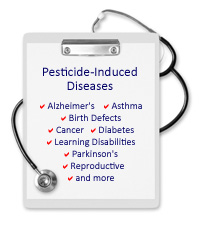 Through a review of scientific literature and publicly available biomonitoring studies, EWG compiled a comprehensive inventory of known or likely carcinogens that have been measured in people. According to the EWG report, data from the National Health and Nutrition Survey, or NHANES, conducted annually by the Centers for Disease Control and Prevention, confirms that many of these carcinogens are in the bodies of Americans not at risk of occupational exposure ‚ÄĒ indeed, at any given time some people may harbor dozens or hundreds of cancer-causing chemicals. Over half of the people tested had levels of arsenic and acrylamide in their bodies high enough to give them a more than 1 in 10,000 risk of cancer. Arsenic is used in certain pesticides, and acrylamide is sometimes found in food packaging and certain foods ‚ÄĚ‚ÄĚpotato chips and French fries have been found to have higher-than-average amounts of it. Other commonly found chemicals included benzene, found in petroleum, and DDT and DDE pesticides.
Through a review of scientific literature and publicly available biomonitoring studies, EWG compiled a comprehensive inventory of known or likely carcinogens that have been measured in people. According to the EWG report, data from the National Health and Nutrition Survey, or NHANES, conducted annually by the Centers for Disease Control and Prevention, confirms that many of these carcinogens are in the bodies of Americans not at risk of occupational exposure ‚ÄĒ indeed, at any given time some people may harbor dozens or hundreds of cancer-causing chemicals. Over half of the people tested had levels of arsenic and acrylamide in their bodies high enough to give them a more than 1 in 10,000 risk of cancer. Arsenic is used in certain pesticides, and acrylamide is sometimes found in food packaging and certain foods ‚ÄĚ‚ÄĚpotato chips and French fries have been found to have higher-than-average amounts of it. Other commonly found chemicals included benzene, found in petroleum, and DDT and DDE pesticides.
‚ÄúThe presence of a toxic chemical in our bodies does not necessarily mean it will cause harm, but this report details the astounding number of carcinogens we are exposed to in almost every part of life that are building up in our systems,‚ÄĚ said Curt DellaValle, author of the report and a senior scientist at EWG in a press release. ‚ÄúAt any given time some people may harbor dozens or hundreds of cancer-causing chemicals. This troubling truth underscores the need for greater awareness of our everyday exposure to chemicals and how to avoid them.‚ÄĚ
One chemical that has recently been in the spotlight is glyphosate, classified as a probable carcinogen based on animal and epidemiological studies by the World Health Organization’s International Agency for Research on Cancer. Glyphosate residues have been detected in foods and products that are not typically associated with heavy glyphosate use. In March 2016,  Moms Across America released a report  on glyphosate residues in California wines. The  report  found  that all of the ten wines tested positive for glyphosate. Other recent reports of the widespread presence of glyphosate residues find the chemical in  breast milk,  in German beers,  feminine hygiene products, and  bread, as well as  in nearly 100% of Germans  tested.
When talking about cancer, it should be noted that Congress in 1958 adopted the Delaney Clause, named for its sponsor Rep. James Delaney (D-NY), which sought to prohibit cancer causing pesticides in food. While just beginning to be implemented in the 1990s, the provision was repealed in part with the adoption of risk assessment language in the 1996 Food Quality Protection Act (FQPA), passed by Congress to amend both the Federal Insecticide, Fungicide and Rodenticide Act and the Federal Food Drug and Cosmetic Act. We cannot fully understand safety without discussing the limits of risk assessment methods that are used to determine ‚Äúacceptable exposure‚ÄĚ or ‚Äúnegligible risk.‚ÄĚ The FQPA requires the Environmental Protection Agency (EPA) to consider available data on the sensitivity of children and other people to pesticides, provide for an extra margin of safety when data is not available, and begin adding up the cumulative impact of exposure to the residue of a single pesticide in all food and water. The act does not require an evaluation of combinations of chemicals or the possible synergistic effects between chemicals, and leaves to the discretion of EPA wide latitude in defining acceptable risk.
The EWG report also outlined research from the Halifax Project, which looks at the potential risks of chemical combinations. In February 2016, a University of California, Los Angeles study found that pesticide mixtures are more harmful that individual pesticides. Pesticide products available for sale are often chemical mixtures of active ingredients that create a cocktail of toxins while studies on pesticide combinations have demonstrated neurological, endocrine, and immune effects at low doses. For example, research conducted by Warren Porter, PhD., professor of zoology and environmental toxicology at the University of Wisconsin, Madison, examined the effect of fetal exposures to a mixture of 2,4-D, mecoprop, and dicamba exposure ‚ÄĚ‚ÄĚfrequently used together in lawn products like Weed B Gone Max and Trillion‚ÄĚ‚ÄĚ on the mother‚Äôs ability to successfully bring young to birth and weaning. Researchers began by testing pesticide concentrations diluted to levels that are considered ‚Äúsafe‚ÄĚ by the U.S. Environmental Protection Agency (EPA). The results were striking: Dr. Porter found that, ‚ÄúThis common lawn pesticide mixture is capable of inducing abortions and resorptions of fetuses at very low parts per billion. The greatest effect was at the lowest dose.‚ÄĚ For more information on pesticide synergy, see Synergy: The Big Unknowns of Pesticide Exposure.
What Can You Do?
EPA’s risk assessment process fails to look at chemical mixtures and synergistic effects, as well as certain health endpoints (such as endocrine disruption), disproportionate effects to vulnerable population groups, and regular noncompliance with product label directions. These deficiencies contribute to its severe limitations in defining real world poisoning, as captured by epidemiologic studies in Beyond Pesticides’ Pesticide-Induced Diseases Database.
Now, it is the growth of organic practices and products that is outpacing regulation in shifting us away from cancer causing chemicals and pesticides. Beyond Pesticides advocates for a regulatory approach  that prohibits high hazard chemical use and calls for alternative assessments. The organization  suggests an approach that focuses on  safer alternatives that are proven effective, such as  organic agriculture. Thus, the best way to avoid pesticide residues in a wide range of food and drinks is to buy and support organic agriculture and the USDA organic label over conventional agriculture. Beyond Pesticides’  database, Eating With a Conscience (EWAC),  provides information on the pesticides that could be present in the food we eat, and why food labeled organic is the right choice. EWAC also includes information on the impacts chemical-intensive agriculture has on farm workers, water, and our threatened pollinators.
Source: Mother Jones, The Pollution in People, EWG Press Release
All unattributed positions and opinions in this piece are those of Beyond Pesticides.
Posted in Announcements, Cancer, Disease/Health Effects, Pesticide Regulation by: Beyond Pesticides
No Comments
14
Jun
(Beyond Pesticides, June 14, 2016) To celebrate National Pollinator Week, June 20-26, 2016, several Washington, DC restaurants have teamed up with Beyond Pesticides and the Center for Food Safety to launch a campaign, ‚ÄúMade by Pollinators,‚ÄĚ to protect pollinators suffering steep declines. With one out of every three bites of food reliant on bees, the participating restaurants‚Äô patrons will be treated to a special menu featuring pollinator-friendly food and provided with information on what they can do to help pollinators. The restaurants hope to increase public awareness on the importance of pollinators and steps that can be taken to reverse the decline. Participating ¬†restaurants include Busboys and Poets, Founding Farmers, Lavagna, the Tabard Inn and Restaurant Nora.
Of the 100 crop varieties that provide 90% of the world’s food, 71 are pollinated by bees.  Honey bees alone pollinate 95 kinds of fruits, nuts and vegetables, such as apples, avocados, almonds, and cranberries. The value of pollination services to U.S. agriculture alone amounts to nearly $30 billion and about 80% of flowering plants require animal pollination.
Honey bees alone pollinate 95 kinds of fruits, nuts and vegetables, such as apples, avocados, almonds, and cranberries. The value of pollination services to U.S. agriculture alone amounts to nearly $30 billion and about 80% of flowering plants require animal pollination.
A recent government survey reports that U.S. beekeepers lost 44 percent of their colonies between spring 2015 and 2016 ‚ÄĒthe second highest loss to date. Numerous studies find that commonly used pesticides ‚ÄĒ both agricultural and residential pesticides‚ÄĒ are a major contributing factor in pollinator declines.
Busboys and Poets said, “Without bees, we wouldn’t be able to serve 99% of our menu. Our participation in Pollinator Week is a small step toward a movement to promote the health of our planet’s ecosystems.”
Nora Pouillon, owner and founder of Restaurant Nora, said, ‚ÄúBees are the most important thing for sustainable food growth, which is one of the reasons I source 100% organic food, free of pesticides that may cause pollinators harm. . . My business partner takes it one step further and raises bees.‚ÄĚ Restaurant Nora is America‚Äôs first certified organic restaurant, committed to serving environmentally conscious cuisine for nearly 40 years.
The Tabard Inn said, “We believe it is important for us and our future generations to protect our environment and encourage smart use of our resources . . . By collaborating with local organic farmers, national organizations, and specialized purveyors, we aim to better the quality of our products, and ultimately everyone’s health. We strive to use pesticide-free, environmentally-responsible products.‚ÄĚ
Jay Feldman, Executive Director of Beyond Pesticides said, ‚ÄúWe deeply appreciate the leadership of these restaurants in protecting bees by sourcing organic and sustainable food, while educating their patrons on the importance of bees in our food system and what they can do to protect pollinators.‚ÄĚ
National Pollinator Week began ten years ago when the U.S. Senate unanimously approved the designation to protect pollinator populations. It has since grown to be an international celebration of the valuable ecosystem services provided by bees, birds, butterflies, bats and all other pollinator species.
#BuildtheBuzz for Pollinator Week with Additional Events
In addition to the “Made by Pollinators” Campaign, here are some things you can do in your community for pollinator week. Here’s what you can do:
1) Organize a Meeting in Your Community. Utilize a public space, such as your local library or community center, have a house party, or host a pollinator-friendly dinner and view the talk Pollinators, Biodiversity and Scientific Integrity, by Jonathan Lundgren, Ph.D. from Beyond Pesticides’ 34th National Pesticide Forum. This is a perfect opportunity to have a discussion with your friends and neighbors about the serious issue of pollinator decline and what you can do.
About the video: Dr. Lundgren is an agroecologist, director of ECDYSIS Foundation, and CEO for Blue Dasher Farm. He is formerly a top U.S. Department of Agriculture (USDA) entomologist, and is the recipient of a prestigious national award for civic courage for his work on neonicotinoids and pollinator decline in the face of agency attempts to suppress his work. One of his priorities is to make science applicable to end-users, and he regularly interacts with the public and farmers regarding pest management and insect biology.
2) Make Change Happen in Your Community. Armed with allies and resources from your video screening party, go to your elected official and ask them to introduce the Model Pollinator Resolution and/or our Model Lawns and Landscapes policy.
>>Get the Model Community Pollinator Resolution here, and our Model Lawns and Landscapes Policy here.
>>For more information, or help with your campaign, see our fact sheet, How to Start Your Own Local Movement, see our BEE Protective webpage, or get in touch with us. Build the buzz in your community to make changes that will protect your local pollinator population!
3) Join the Keep the Hives Alive Tour!
As part of nationwide efforts to raise awareness about the decline of honey bees and other pollinators, the Keep the Hives Alive tour will travel the country urging Congress, EPA, and USDA to take real action to protect these critical species from toxic pesticides. The tour is organized by beekeepers, farmers, farmworkers, scientists and advocates and will stop in South Dakota, Minnesota, Michigan, Pennsylvania, North Carolina and Washington, DC before and during National Pollinator Week, June 13-23. Beekeepers will drive a bee truck between each stop, with a display of dead bees to demonstrate one beekeepers loss.
Please participate if you are located near any of the stops on the tour!
Use the Facebook event pages to get more involved:
o     Estellinne, South Dakota: Blue Dasher Farms, kicked off yesterday, June 13th.
o     Montevideo, Minnesota: Moonstone Farms, June 14th
o     Ypsilanti, Michigan: Recreation Park, June 16th
o     Detroit, Michigan: D-Town Farm, June 16th
o     Lewisburg, Pennsylvania: Hackenburg Apiaries, June 18th
o     Research Triangle Park, North Carolina: Bayer Headquarters, June 20th
o     Washington, DC: EPA Headquarters, June 22nd.
We hope you’ll be able to attend one of these critical grassroots events before and during Pollinator Week!
For more information on what you can do to protect pollinators, see www.beeprotective.org.
All unattributed positions and opinions in this piece are those of Beyond Pesticides.
Posted in Announcements, Events, Michigan, North Carolina, North Dakota, Pennsylvania, Pollinators, South Dakota, State/Local, Take Action, Washington D.C., Wildlife/Endangered Sp. by: Beyond Pesticides
No Comments
13
Jun
(Beyond Pesticides June 13, 2016) A federal judge in California handed down a decision last week agreeing with the Environmental Protection Agency’s (EPA) that it has no responsibility under federal pesticide law to complete rulemaking on the disclosure of hazardous ingredients in pesticide products. That means that if the decision stands EPA will be allowed to keep the public in the dark on the full list of toxic ingredients in pesticides registered by the agency. A lawsuit filed by the Center for Environmental Health, Beyond Pesticides, and Physicians for Social Responsibility argues that EPA fails to protect consumers from ‚Äúinert‚ÄĚ ingredients found in pesticides.
 U.S. District Judge William Orrick stated in his ruling,‚ÄúThe EPA has no mandatory duty to require disclosure of ‚Äúinert‚ÄĚ ingredients in pesticides, even if those ingredients qualify as hazardous chemicals under separate statutes.‚ÄĚ Advocates have said for decades that people and communities cannot make informed decisions on pesticide products without full disclosure of all product ingredients and that the stated proprietary interests of chemical manufacturers is bogus, given the burgeoning market of pesticide products exempt from registration under the Federal Insecticide, Fungicide and Rodenticide Act (FIFRA) 25(b) provision, which are required to disclose all ingredients.
U.S. District Judge William Orrick stated in his ruling,‚ÄúThe EPA has no mandatory duty to require disclosure of ‚Äúinert‚ÄĚ ingredients in pesticides, even if those ingredients qualify as hazardous chemicals under separate statutes.‚ÄĚ Advocates have said for decades that people and communities cannot make informed decisions on pesticide products without full disclosure of all product ingredients and that the stated proprietary interests of chemical manufacturers is bogus, given the burgeoning market of pesticide products exempt from registration under the Federal Insecticide, Fungicide and Rodenticide Act (FIFRA) 25(b) provision, which are required to disclose all ingredients.
An ¬†inert ingredient ¬†is defined as any ingredient that is ‚Äúnot active,‚ÄĚ or specifically targeted to kill a pest. According to a 2000 report produced by the New York State Attorney General, ¬†The Secret Ingredients in Pesticides: Reducing the Risk, 72 percent of pesticide products available to consumers contain over 95 percent inert ingredients and fewer than 10 percent of pesticide products list any inert ingredients on their labels. The report also found that more than 200 chemicals used as inert ingredients are hazardous pollutants in federal environmental statutes governing air and water quality, and, from 1995 list of inert ingredients, 394 chemicals were listed as active ingredients in other pesticide products. For example, naphthalene is an inert ingredient in some products and listed as an active ingredient in others.
Some inert ingredients are even more toxic than the active ingredients. One of the most hazardous ingredients in the commonly used herbicide Roundup, POEA, is a surfactant, which is classified as an inert and therefore not listed on the label. Researchers have found that  POEA can kill human cells, particularly embryonic, placental and umbilical cord cells.
A decision in this case has been long awaited, as the dispute began back in 2006 when Beyond Pesticides and other groups petitioned the EPA to require pesticide manufacturers to disclose 371 inert ingredienton their pesticide product labels. After an extended period of time, in 2009 EPA  finally  responded  to the petition asking it to require that inert ingredients be identified on the labels of produc
ts that include them in their formulations. Then, on December 23, 2009, EPA took another promising step forward with an ¬†Advanced Notice of Proposed Rulemaking (ANPR), announcing its intention to seek public input on developing an inert ingredient disclosure rule. Putting forth two proposals, one would require listing of all ingredients already identified as hazardous and the other would require listing of all ingredients. Unfortunately, EPA has taken no further action since then. As a result, some of the original petitioners ¬†filed an ‚Äúundue delay‚ÄĚ complaint ¬†against EPA ¬†in 2014 ¬†for failing to complete rulemaking that would require pesticide manufacturers to disclose ¬†the inert ingredients on ¬†their pesticide product labels.
In response to that lawsuit, EPA retracted its previous ANPR and intention to move forward with rulemaking. Instead, EPA issued a ¬†letter ¬†to the original 2006 petitioners describing its intentions to seek non-rulemaking regulatory programs and voluntary disclosure standards, stating, ‚ÄúIn sum, [EPA] believe[s] we have identified a more effective and timely way to achieve our common objective; but, because this approach would no longer pursue the rulemaking the EPA initiated via the [ANPR] seeking to mandate the disclosure of potentially hazardous inert ingredients on pesticide labels, as requested in the 2006 petitions, this amended response constitutes a denial of the petitions.‚ÄĚ
EPA then used its change of position and denial of the 2006 petition as a basis to have the undue delay lawsuit thrown out because it would no longer be issuing a rulemaking.
In response to this, plaintiffs filed this current lawsuit, advocating against EPA‚Äôs current policy to encourage voluntary disclosure by manufacturers, given that it has not been effective to-date in making people aware of what inert ingredients are found in pesticides. They also continue to argue that the toxic ingredients in question clearly meet the standard for ‚Äúunreasonable risk‚ÄĚ which the EPA is tasked with combating under FIFRA.
The failure of EPA to require the disclosure of inert ingredients poses many problems for those trying to protect human health. Failure  to disclose the ingredients not only prevents consumers and decision makers from making informed decisions and comparing hazards. Local and state governments also run into roadblocks in their efforts to protect citizens, as they cannot readily evaluate what is in the pesticides products (formulations) that they are spraying in their communities to make independent judgments on safety, putting their citizens at risk. Under the prevailing laws, it is EPA’s duty to assess these risks and disclose the necessary information, through pesticide labels, as to what harmful ingredients pesticides contain.
Beyond Pesticides has long advocated a regulatory approach ¬†that prohibits hazardous chemical use and requires alternative assessments to identify less toxic practices and products under the unreasonable ¬†adverse effects clause of FIFRA. ¬†Beyond Pesticides was a co‚Ä̬źplaintiff in the successful lawsuit Northwest Coalition for Alternatives to Pesticides et al. v. EPA (Civil Action No. 94‚Ä̬ź1100, 1996), in which the court ruled that ‚Äúinert‚ÄĚ ingredients should not be given blanket trade secret protection by EPA under the Freedom of Information Act (FOIA). In that ¬†case, the plaintiffs successfully argued that EPA must disclose inert ingredients since their secrecy from public disclosure served no proprietary interest for the chemical manufacturer. This same argument holds with respect to the product label.
Environmental groups, including Beyond Pesticides, have consistently urged EPA to follow in the steps of countries like Canada and the European Union by following the precautionary principle, which generally approves products after they have been assessed for harm, not before. Beyond Pesticides  suggests an approach that rejects uses and exposures deemed acceptable under risk assessment calculations, and instead focuses on  safer alternatives that are proven effective, such as  organic agriculture, which prohibits the use of toxic chemicals.
All unattributed positions and opinions in this piece are those of Beyond Pesticides.
Source: Courthouse News Service
Posted in Agriculture, Alternatives/Organics, Announcements, Chemicals, Litigation, National Politics by: Beyond Pesticides
1 Comment
10
Jun
(Beyond Pesticides, June 10, 2016) A proposal for a temporary ‘technical extension’ of the EU approval of the herbicide glyphosate failed to secure the support of a majority of EU governments at a meeting of the EU standing committee on plants, animals, food and feed on Monday. This action may force the withdrawal of the herbicide, widely sold as Monsanto‚Äôs Roundup, from shelves if no decision is reached by the end of the month, when its license expires.
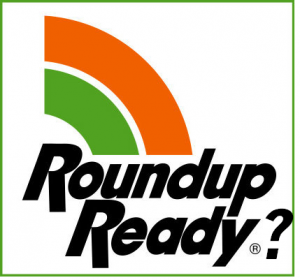 After a proposal to renew the license for glyphosate for up to 15 years failed to win support in two meetings earlier this year, the EU executive offered a limited 12 to 18 month extension to allow time for further scientific study. Yet, despite this compromise, the proposal failed to win the support of member states representing at least 65% of the EU’s population, which is needed for adoption, an EU official told The Guardian. Seven member states abstained from Monday’s vote, 20 backed the proposal and one voted against, a German environment ministry spokeswoman said. According to the news source, Germany was among those that abstained from Monday’s vote. Of note is that Bayer, the German chemical company, recently offered to buy the Monsanto.
After a proposal to renew the license for glyphosate for up to 15 years failed to win support in two meetings earlier this year, the EU executive offered a limited 12 to 18 month extension to allow time for further scientific study. Yet, despite this compromise, the proposal failed to win the support of member states representing at least 65% of the EU’s population, which is needed for adoption, an EU official told The Guardian. Seven member states abstained from Monday’s vote, 20 backed the proposal and one voted against, a German environment ministry spokeswoman said. According to the news source, Germany was among those that abstained from Monday’s vote. Of note is that Bayer, the German chemical company, recently offered to buy the Monsanto.
Bart Staes, the Greens/EFA group environment and food safety spokesperson said in a statement:
“We applaud those EU governments who are sticking to their guns and are refusing to authorise this controversial toxic herbicide. ¬†There are clear concerns about the health risks with glyphosate, both as regards it being a carcinogen and an endocrine disruptor. Moreover, glyphosate’s devastating impact on biodiversity should have already led to its ban. Thankfully, the significant public mobilisation and political opposition to reapproving glyphosate has been taken seriously by key EU governments, who have forced the Commission to back down.‚ÄĚ
“Three strikes must mean the approval of glyphosate is finally ruled out. After the third failed attempt, the Commission must stop continuing to try and force through the approval of glyphosate. Such a move would raise major democratic concerns about the EU’s decision-making process. The process of phasing out glyphosate and other toxic herbicides and pesticides from agriculture must begin now, and this means reorienting the EU’s Common Agricultural Policy towards a more sustainable agricultural model.”
Glyphosate, produced and sold by Monsanto, is often touted as a ‚Äúlow toxicity‚ÄĚ chemical and ‚Äúsafer‚ÄĚ than other chemicals by industry. But recent research ¬†links chronic, ultra-low dose exposure to glyphosate in drinking water to adverse impacts on the health of liver and kidneys. Previous epidemiologic studies have found that exposure to glyphosate is significantly ¬†associated ¬†with an increased risk of non-Hodgkin‚Äôs ¬†Lymphoma ¬†(NHL), even though these studies have been discounted. In addition to impacts on human health, glyphosate has been linked to adverse effects on earthworms and other soil biota, as well as ¬†shape changes in amphibians. The widespread use of the chemical on genetically engineered glyphosate-resistant crops has led it to be implicated in the ¬†decline of monarch butterflies, whose sole source to lay their eggs, milkweed plants, are being devastated as a result of incessant use of glyphosate.
Glyphosate has been subject to widespread public scrutiny since the International Agency for Research on Cancer (IARC) classified it as a 2A probable carcinogen ¬†based on animal studies. ¬†Months after the IARC review, the European Food Safety Authority (EFSA), an independent agency funded by the European Union, published a different assessment, saying glyphosate is ‚Äúunlikely to pose a carcinogenic hazard to humans.‚ÄĚ However, EFSA‚Äôs report is limited in that it reviewed glyphosate alone, unlike IARC which reviewed glyphosate and its formulated products, which are more relevant for evaluating risks to human health. And, just last month, a joint review by the United Nations (UN) and World Health Organization (WHO) on ¬†glyphosate seemed to contradict those findings, however the review looks at pesticide residues in food, and does not look at other sources of exposure. Separating independent scientific findings or interpretation of data from those influenced by chemical industry interests has been a long standing problem in the public debate and media discussion on pesticide hazards.
On the other hand, one scientist who was a part of IARC’s expert panel that reviewed glyphosate  spoke of glyphosate’s genotoxic potential, stating  that the herbicide can damage human DNA, which can  result in increased cancer risks. And, a  scientific review  was released in February 2016 by a group of 14  scientists, which expressed concern about the widespread use of glyphosate-based herbicides (GBHs), the lack of understanding regarding human exposure, and the potential health impacts. According to the report, U.S. agencies, such as the National Toxicology Program, the Centers for Disease Control and Prevention, and EPA, have not adequately kept up with cutting-edge research. The researchers call for the global science and regulatory community to step back and take a fresh look at glyphosate due to widespread exposure patterns. A 2008 study confirms that the ingredients in Roundup formulations kill human cells, particularly embryonic, placental and umbilical cord cells, even at very low concentrations, and causes total cell death within 24 hrs.
Further, glyphosate residues have been detected in foods and products that are not typically associated with heavy glyphosate use, and  even in organic foods and products, in which the use of glyphosate is prohibited. Recent reports of the widespread presence of glyphosate residues find the chemical in California wines,  breast milk,  in nearly 100% of Germans and  in German beers,  feminine hygiene products, and  bread. Other sources of exposure include agricultural spraying. A 2015 report found that 54 percent of glyphosate spraying in California is applied in eight counties, many of which are located in the southern part of the Central Valley. The analysis finds that the populations in these counties are predominantly Hispanic or Latino, indicating that glyphosate use in California is distributed unequally along both socioeconomic and racial lines.
In addition to impacts on human health, glyphosate has been linked to adverse effects on  earthworms and other soil biota, as well as  shape changes in amphibians. The widespread use of the chemical on genetically engineered glyphosate-resistant crops has led it to be implicated in the  decline of monarch butterflies, whose sole source to lay their eggs, milkweed plants, are being devastated as a result of incessant use of glyphosate.
Beyond Pesticides urges individuals concerned about glyphosate exposure to support organic systems that do not rely on hazardous carcinogenic pesticides. In agriculture, concerned consumers can  buy food with the certified organic label, which not only disallows synthetic pesticides like glyphosate, but also the use of sewage sludge and genetically engineered ingredients. Instead of prophylactic use of pesticides and biotechnology, responsible organic farms focus on fostering habitat for pest predators and other beneficial insects, and only resort to judicious use of least-toxic pesticides when other cultural, structural, mechanical, and biological controls have been attempted and proven ineffective.
For more information, watch Pesticides and Diseases: What Do We Know and What Do We Need? by Aaron Blair, Ph.D. a National Cancer Institute researcher (emeritus), author of more than 450 publications on occupational and environmental causes of cancer,  and the overall chair of the International Agency for Research on Cancer’s (IARC) evaluation panel that found  glyphosate (Roundup) to be a carcinogen. And, see Beyond Pesticides’ article  Glyphosate Causes Cancer.
Source: The Guardian
All unattributed positions and opinions in this piece are those of Beyond Pesticides.
Posted in Agriculture, Announcements, Glyphosate, International, Pesticide Regulation, Pesticide Residues, Pollinators by: Beyond Pesticides
No Comments
09
Jun
(Beyond Pesticides, June 9, 2016) The U.S. Congress passed a bill Tuesday to reform the Toxic Substances Control Act (TSCA) of 1976, the national law that regulates industrial chemicals, but in the process took away the right of state governments to adopt more stringent standards than the federal government. A Senate voice vote late Tuesday passed the bill, following a House vote in late May. The bill will now go to President Obama‚Äôs desk for signature or veto, but it is likely that he will sign it into law. Congress has taken steps to address the vast shortcomings of the law to protect human health and safety, and ¬†in the process has created opportunities for serious delays and restrictions on states‚Äô ability to enact their own toxic chemical regulations. ¬†As the bill heads to President Obama, environmental advocates are concerned that they will lose an important tool in the fight for public protections ‚ÄĒwith the adoption of federal legislation that will ¬†diminish the right of states and communities to establish protective laws, regulations, and standards in the face of involuntary toxic chemical exposure.
 Under  current TSCA law, around 64,000 chemicals are not subject to environmental testing or regulation by the Environmental Protection Agency (EPA). In absence of federal reform over the past 40 years, many states, including Washington, Connecticut, New Hampshire, Minnesota, New York and Vermont, have stepped up to fill the void, taking actions, such as setting exposure limits lower than federal levels and enacting bans on dangerous toxic products like lead-weighted wheels and flame retardant mattresses.
Under  current TSCA law, around 64,000 chemicals are not subject to environmental testing or regulation by the Environmental Protection Agency (EPA). In absence of federal reform over the past 40 years, many states, including Washington, Connecticut, New Hampshire, Minnesota, New York and Vermont, have stepped up to fill the void, taking actions, such as setting exposure limits lower than federal levels and enacting bans on dangerous toxic products like lead-weighted wheels and flame retardant mattresses.
The reform will change existing TSCA in a number of ways, such as:
- establish a health-based safety standard;
- require the EPA to assess the risk of existing chemicals under “judicially enforceable deadlines,” without consideration of cost. This process will include identification of substances on the market, designation of low and high priorities, risk evaluation of high-priority substances, and restrictions for those that ¬†present an unreasonable risk;
- strike the existing statute’s mandate that the EPA implement “least burdensome” regulatory requirements;
- mandate that the EPA make “an affirmative safety finding” before allowing a new substance on the market, under a 90-day review period (which may be extended to 180 days);
- increases the EPA’s authority to order testing, with a requirement to “reduce and replace animal testing where scientifically reliable alternatives exist”;
- trigger an EPA review of all past confidential business information (CBI) claims, and require re-substantiation of approved claims after ten years;
- limit state authority to restrict substances that are undergoing EPA review, have been found by the agency not to pose unreasonable risk, or are subject to federal risk management, unless they seek out a waiver. States’ authority to require reporting and monitoring are preserved, and chemical restrictions enacted prior to 22 April 2016 are ‘grandfathered’ in;
- call for identification and protection of most vulnerable populations;
- require science-based decisions, founded on weight of evidence (WoE); and
- collect fees on  new and existing chemicals that  go directly to the EPA.
While the final bill looks better in some ways than where it started, it does not look good on one of the issues that matters most ‚ÄĒ state preemption. In addition, the legislation embraces a risk assessment approach to regulating toxic chemicals, similar to the regulation of pesticides under the Federal Insecticide, Fungicide and Rodenticide Act (FIFRA), which has proven to allow the unnecessary use of toxic chemicals under a “health-based safety standard” for which there are safer less-toxic practices and products. Because of the limitations of risk assessment, which is often politicized or subject to political pressure, it is critical that FIFRA does not preempt state or local authority ‚ÄĒalthough the legislatures of 43 states have stripped their local political subdivisions of the authority to adopt more stringent standards after heavy lobbying from the chemical industry in the 1990’s. States have on occasion ¬†used this authority when they determine that federal government action is inadequately protective, as Maryland and Connecticut recently did in restricting the sale of bee-toxic neonicotinoid pesticides and other states consider similar action.
State authorities, public health groups, and environmental advocates alike have cause for concern. Lobbying for  preemption laws that strip states and localities of their authority to restrict toxic chemical use is a tried and true practice of the chemical industry. Arguing under the guise of coherence and a unified national approach, chemical industry leaders would prefer weaker, uniform standards that fail to account for localized needs and sensitive populations. As written, the bill relies on EPA to protect public health, an obligation that the agency continually falls short on, while simultaneously making it more difficult for states to go above and beyond EPA standards. Meanwhile, extreme legislators and public figures, including presidential hopeful Donald Trump, have called for the elimination of EPA, raising questions about the agency’s longevity as a regulatory entity able to protect citizens from the harms associated with toxic chemicals. If the reformed bill is signed into law by President Obama, state authority to act and protect beyond the federal scope would be undermined.
Beyond Pesticides has maintained that it is essential to uphold the basic principle that states and localities have the authority to adopt more restrictive standards than the federal government. In fact, because federal pesticide and toxic laws have upheld the right of states to exceed federal standards for pesticide use, stronger federal law has resulted over time. Pesticides, such as DDT, DBCB, chlordane, EDB, and others were first banned by states, followed by federal action.
In the face of weak federal and state laws, even in states that preempt local authority to restrict toxic chemical use in public spaces and private property, you can work with your local government to adopt an ordinance that stops local government use of toxic chemicals on all public property, land and buildings. See Beyond Pesticides’ Tools for Change on how to get started with a local campaign, contact us at [email protected], or call 202-543-5450.
Source: Politico, Chemical Watch
All unattributed positions and opinions in this piece are those of Beyond Pesticides.
Posted in Agriculture, Alternatives/Organics, Announcements, National Politics, Pesticide Regulation, Take Action by: Beyond Pesticides
No Comments
08
Jun
(Beyond Pesticides, June 8, 2016) With years of data documenting the harmful impacts of the herbicide atrazine on aquatic organisms and other wildlife, a recent U.S. Environmental Protection Agency (EPA) assessment now concludes that this widely used chemical poses risks to fish, amphibians, aquatic invertebrates, and even birds, reptiles and mammals. Atrazine is a potent endocrine disruptor with strong associations with birth defects, sex reversal and hermaphroditism in organisms, and whose risk to environmental and human health is exacerbated by pervasive surface, ground and drinking water contamination.
 Last week, EPA released its triazine ecological risk assessments for atrazine and its chemical cousins simazine, and propazine. The assessments evaluated risks to animals and plants including, amphibians, birds, mammals, fish, reptiles, aquatic invertebrates, aquatic plant communities, and terrestrial plants. ¬†EPA is currently in the registration review process for these chemicals. For atrazine, EPA concludes, ‚Äúaquatic plant communities are impacted in many areas where atrazine use is heaviest, and there is potential chronic risks to fish, amphibians, and aquatic invertebrate in these same locations. In the terrestrial environment, there are risk concerns for mammals, birds, reptiles, plants and plant communities across the country for many of the atrazine uses.‚ÄĚ Levels of concerns were exceeded by as much as 200-fold for some organisms! When it comes to amphibians, impacts which have been extensively documented by researchers like Tyrone Hayes, PhD, at the University of California, Berkeley, EPA finds that ‚Äúthere is potential for chronic risks to amphibians based on multiple effects endpoint concentrations compared to measured and predicted surface water concentrations.‚ÄĚ Previous scientific reviews, like the 2009 analysis of more than 100 scientific studies conducted on atrazine, found evidence that atrazine harms fish and frogs.
Last week, EPA released its triazine ecological risk assessments for atrazine and its chemical cousins simazine, and propazine. The assessments evaluated risks to animals and plants including, amphibians, birds, mammals, fish, reptiles, aquatic invertebrates, aquatic plant communities, and terrestrial plants. ¬†EPA is currently in the registration review process for these chemicals. For atrazine, EPA concludes, ‚Äúaquatic plant communities are impacted in many areas where atrazine use is heaviest, and there is potential chronic risks to fish, amphibians, and aquatic invertebrate in these same locations. In the terrestrial environment, there are risk concerns for mammals, birds, reptiles, plants and plant communities across the country for many of the atrazine uses.‚ÄĚ Levels of concerns were exceeded by as much as 200-fold for some organisms! When it comes to amphibians, impacts which have been extensively documented by researchers like Tyrone Hayes, PhD, at the University of California, Berkeley, EPA finds that ‚Äúthere is potential for chronic risks to amphibians based on multiple effects endpoint concentrations compared to measured and predicted surface water concentrations.‚ÄĚ Previous scientific reviews, like the 2009 analysis of more than 100 scientific studies conducted on atrazine, found evidence that atrazine harms fish and frogs.
The results are similar for simazine and propazine, since all three triazines show similar effects at similar concentrations. Simazine, which is frequently detected in surface and groundwaters, was found to have potential chronic risks to mammals and birds. Simazine spray drift and runoff can also impact non-target plants. For propazine, which has minimal uses (preemergent control in sorghum and container grown ornamentals in greenhouses only), the agency identified chronic risks to mammals, birds and non-target plants. All three chemicals are mobile and persistent in the environment, which results in water contamination. According to the U.S. Geological Survey (USGS), atrazine is one of the most frequently detected pesticides, found at concentrations at or above aquatic benchmarks, and is also frequently detected in shallow ground water in agricultural areas, and in urban streams. Similarly, a 2009 report by the Natural Resource Defense Council (NRDC) ‚ÄúPoisoning the Well,‚ÄĚ 97% of surface drinking water systems in Midwestern States show atrazine contamination. Atrazine‚Äôs manufacturer, Syngenta, reached a class action settlement in 2012 with water utilities across the country to clean up atrazine in drinking water supplies. This case, City of Greenville v. Syngenta Crop Protection, Inc., and Syngenta AG, Case No. 3:10-cv-00188- JPG-PMF, showed that atrazine contaminated community water systems‚Äô raw and finished water. The lawsuit claimed that atrazine at any level injures water supply systems, and requested that Syngenta bear the cost of removing atrazine from water systems.
Since atrazine water contamination is so pervasive, risks to sensitive aquatic species are especially important. Specifically, EPA finds that atrazine chronic levels at or above 5ppb lead to reproductive effects in fish, while exposures to levels of 3.4ppb for 60 days or more can impact aquatic plants’ productivity, structure and function. The agency acknowledges that the observed impacts occur at levels below those that have been found through environmental monitoring, as well as at EPA’s safe drinking water standard (3ppb). Studies by Dr. Hayes and others have shown that concentrations as little as 0.1ppb impact hormone function in organisms and turns tadpoles into hermaphrodites Рcreatures with both male and female sexual characteristics. Research also finds that atrazine interferes with mammary gland development in the breast of mammals and is linked to certain birth defects like gastroschisis and choanal atresia, which are significantly increased for pregnant women with high levels of atrazine exposure.
EPA‚Äôs recent triazine assessments are not without challenge from industry groups that ¬†disagree with the findings and the studies EPA used to reach its conclusion. Industry groups still contend that atrazine is ‚Äúsafe‚ÄĚ to use despite a wealth of scientific evidence from independent researchers which say otherwise. Atrazine is currently banned in the European Union over concerns of widespread water contamination. Environmental groups have long called for the U.S. to follow Europe and ban atrazine. A 2014 study published in the ¬†International Journal of Occupational and Environmental Health ¬†found that ¬†banning atrazine would result in net economic benefit to farmers. ¬†Given that over 70 million pounds of atrazine are used annually, the serious ecological impacts associated with its continued use, and the availability of alternatives, advocates argue that atrazine use must come to an end. View Dr. Hayes’ keynote talk on atrazine and endocrine disruption at Beyond Pesticides’ ¬†33rd National Pesticide Forum in 2015.
EPA‚Äôs draft assessments are now ¬†open for public comment ¬†and will be followed later this year by an assessment of atrazine‚Äôs ¬†human health effects. EPA will have atrazine’s assessment peer reviewed by the Scientific Advisory Panel in 2017. Submit your comments for Atrazine (EPA-HQ-OPP-2013-0266), Simazine (EPA-HQ-OPP-2013-0251) and Propazine (EPA-HQ-OPP-2013-0250) by August 5, 2016.Source: EPA News Release
All unattributed positions and opinions in this piece are those of Beyond Pesticides.
Posted in Announcements, Atrazine, Chemicals, Litigation, National Politics, Pesticide Regulation, Pesticide Residues, Take Action, Water, Wildlife/Endangered Sp. by: Beyond Pesticides
14 Comments
07
Jun
(Beyond Pesticides, June 7, 2016) A wholesale change in agricultural practices is necessary to ensure protection of human health and the environment over the long-term, according to a wide-ranging report authored by the International Panel of Experts on Sustainable Food Systems (IPES), “a fully independent panel, without financial or organizational ties to any corporations, governments or intergovernmental agencies.” The report, From Uniformity to Diversity, calls for a paradigm shift from industrial agriculture to diversified agroecological systems.
 According to the report, diversified agroecology focuses on maintaining multiple sources of food production, and farming by applying ecological concepts and principles to the design and management of food systems. Industrial agriculture, on the other hand, requires highly-specialized production of a single food crop, and, through scale and task separation, focuses on increasing productivity through intensification. While monocultures and concentrated animal feeding operations (CAFOs) are characteristic of industrial agriculture, agroecological practices embrace spatial and temporal diversification (through practices like crop rotation and intercropping), and focus on multiple outputs.
According to the report, diversified agroecology focuses on maintaining multiple sources of food production, and farming by applying ecological concepts and principles to the design and management of food systems. Industrial agriculture, on the other hand, requires highly-specialized production of a single food crop, and, through scale and task separation, focuses on increasing productivity through intensification. While monocultures and concentrated animal feeding operations (CAFOs) are characteristic of industrial agriculture, agroecological practices embrace spatial and temporal diversification (through practices like crop rotation and intercropping), and focus on multiple outputs.
Oliver De Schutter, Ph.D., former United National special rapporteur on food and co-chair of IPES, notes to The Guardian: ‚ÄúMany of the problems in food systems are linked specifically to the uniformity at the heart of industrial agriculture, and its reliance on chemical fertilisers and pesticides.‚ÄĚ
Although the report explains that organic farming practices are often synonymous with agroecological principles, as many organic farms are diversified enterprises that focus on holistic management practices, organic certification does not require this approach. However, Beyond Pesticides points out that there is neither a legal nor standardized definition of agroecology or sustainable agriculture, while certified organic is accountable to a public rulemaking process and defined by law, the Organic Foods Production Act, which ¬†requires an “organic systems plan. . .that includes written plans concerning all aspects of agricultural production or handling described in this title including crop rotation and other practices as required under this title.” Furthermore, by law, synthetic fertilizers are specifically prohibited in organic systems, as are other synthetic materials, except those in limited ¬†categories [7 USC 6527(c)(1)(B)(i)] that are “not harmful to health or ¬†the environment,” are essential to organic systems because of the “unavailability of a wholly natural substitute,” and is “consistent with” organic farming. While the principles of organic can be applied to large-scale operations, the crop production farm plan ¬†“shall contain provisions designed to foster soil fertility, primarily through the management of the organic content of the soil through proper tillage, crop rotation, and manuring.” ¬†A ¬†study published earlier this year by researchers at Washington State University deemed organic agriculture essential to a sustainable food system.
There are efforts underway to attach a social justice component to organic. The Agricultural Justice Project seeks to “ensure fair treatment of workers, fair pricing for farmers, and fair business practices” in organic production. View ¬†speech, Social Justice Labeling -From Field to Table, or written version, on this subject by Michael Sligh, Rural Advancement Fund International. Similarly, the Center for Agroecology & Sustainable Food Systems (CASFS) at University of California Berkeley functions ¬†to research, develop, and advance sustainable food and agricultural systems that are environmentally sound, economically viable, socially responsible, nonexploitative, and that serve as a foundation for future generations.
From Uniformity to Diversity argues that industrial agriculture persists due to a concentration of power that ‚Äúlocks in‚ÄĚ the current structure, allowing relatively few large companies to dominate markets and profits. ‚ÄúFood systems in which uniform crop commodities can be produced and traded on a massive scale are in the economic interests of crop breeders, pesticide manufacturers, grain traders and supermarkets alike,‚ÄĚ says the report. ‚ÄúThe mismatch between the potential of agroecology ¬† to ¬† improve ¬† food ¬† systems ¬† outcomes, and its potential to generate profit for agribusinesses, ¬† may ¬† explain ¬† why ¬† it ¬† has ¬† been ¬† so slow ¬† to ¬† make ¬† its ¬†way ¬† onto ¬† the ¬† global ¬† political agenda.‚ÄĚ
The authors do identify opportunities and recommendations to begin shifting the current paradigm toward a healthier, ecological based food system. This includes changing the way productivity is measured to reflect resiliency, resource efficiency, nutritional quality, biodiversity, provision of ecosystem services, and impacts on livelihood and equity rather than simply net calorie production, yield and income. Also imperative is a switch from long to short supply chains by way of local markets, which can be facilitated by food policy councils, local exchange and trading systems, and farmer‚Äôs markets. Public support must be shifted toward diverse agricultural systems, social movements around sustainable farming systems must coalesce, and holistic approaches must become part of education and research agendas. The report asserts that, “[T]he vicious cycles of industrial agriculture must be replaced with new virtuous circles; the various steps in favour of diversified agroecological systems can and must lock each other in, just as current dynamics act to lock them out.‚ÄĚ To counter the industrial model, the report calls for ‚Äújoined-up food policies‚ÄĚ at the regional, national, and global level.
Beyond Pesticides is working to strengthen organic farming systems by encouraging biodiversity and holistic management practices, and upholding the spirit and values  on which the organic law was founded. Underpinning the success of organic in the U.S. are small-scale producers who focus on fostering biodiversity, limiting external inputs, improving soil health, sequestering carbon, and using integrated holistic approaches to managing pests, weeds, and disease. As a 2014 University of California Berkeley study determined that  diversified organic agriculture can and must be the approach used to feed the world into the future.
All unattributed positions and opinions in this piece are those of Beyond Pesticides.
Source: The Guardian, IPES Report, Uniformity to Diversity
Posted in Agriculture, Alternatives/Organics, Announcements by: Beyond Pesticides
1 Comment
06
Jun
(Beyond Pesticides, June 6, 2016) Bayer CropScience’s appeal of the cancellation of their toxic pesticide flubendiamide by the U.S. Environmental Protection Agency (EPA) was rejected by EPA‚Äôs Chief Administrative Law Judge (ALJ) Susan Biro on Thursday, June 1. Judge Biro dismissed the complaints, saying that the agency was acting within its authority when it pulled its approval for the pesticide earlier this year after the two manufacturers, Bayer CropScience and Nichino America, failed to meet the terms laid out in a 2008 conditional registration. A startling number of pesticides, nearly 65% of the more than 16,000 pesticides now on the market, were first approved by the process of ‚Äúconditional registration,‚ÄĚ a loophole in which EPA allows new pesticides on the market without the full range of legally mandated toxicity tests for a full registration. Meanwhile, the Canadian Pest Management Regulatory Agency finalized its ¬†decision to discontinue granting new conditional registrations, also on June 1.
 In 2008, EPA granted Bayer a ‚Äúconditional‚ÄĚ registration for flubendiamide, a classification that allows a new pesticide to be registered and used in the field, despite outstanding data points on its toxicological impact. In this case, original data submitted to EPA by Bayer showed concern over the effect of the chemical and its breakdown product on freshwater benthic invertebrates, species such as crustaceans and aquatic insects that ¬†live in stream sediment and provide important ecosystem services such as decomposition and nutrient cycling. In response, rather than declining to proceed with registration of the chemical, EPA negotiated a deal with Bayer to conditionally register the chemical for five ¬†years with additional label restrictions, while it waited for more ¬†data on the harm to benthic species.
In 2008, EPA granted Bayer a ‚Äúconditional‚ÄĚ registration for flubendiamide, a classification that allows a new pesticide to be registered and used in the field, despite outstanding data points on its toxicological impact. In this case, original data submitted to EPA by Bayer showed concern over the effect of the chemical and its breakdown product on freshwater benthic invertebrates, species such as crustaceans and aquatic insects that ¬†live in stream sediment and provide important ecosystem services such as decomposition and nutrient cycling. In response, rather than declining to proceed with registration of the chemical, EPA negotiated a deal with Bayer to conditionally register the chemical for five ¬†years with additional label restrictions, while it waited for more ¬†data on the harm to benthic species.
The agency issued a Notice of Intent to Cancel (NOIC) the insecticide on March 4, finding that the company failed to comply with its conditional pesticide registration, backing EPA’s novel process to quickly cancel pesticides and upholding EPA’s ban on sales of existing flubendiamide stocks. The judge found that the agency’s actions in relation to the pesticide have all been consistent with the Federal Insecticide, Fungicide and Rodenticide Act (FIFRA).
As part of the additional data requirements, EPA requested a study to investigate the utility of 15 foot buffer zones (part of the new label requirements EPA assumed would mitigate hazards to benthic organisms). In a novel move, EPA‚Äôs agreement with Bayer indicated that the pesticide‚Äôs conditional registration would expire in 2013, and if additional data revealed ‚Äúunreasonable adverse effects,‚ÄĚ it would notify the ¬†company, which would then voluntarily withdraw the chemical from the market.
Judge Biro says the agency’s arguments were essentially ‚Äúunopposed‚ÄĚ in the case, calling Bayer’s arguments untimely and unconvincing. ‚ÄúPetitioners do not dispute that after reviewing the data, EPA made a determination, as evidenced by its January 29, 2016 letter to them that further registration of the flubendiamide products ‘will result in unreasonable adverse effects on the environment.’‚ÄĚ
A Bayer spokesman, in a statement to Inside EPA, said that the order is ‚Äúdisappointing for supporters of science-based regulations and grower choice, but it was not unexpected, given the Judge‚Äôs prior preliminary rulings, including her decision to exclude any discussion of the scientific issues raised by EPA‚Äôs actions on flubendiamide.‚ÄĚ
However, since its conditional registration, studies showed that flubendiamide ‚ÄĒwhich is registered for use on over 200 crops, including soybeans, almonds, tobacco, peanuts, and cotton‚ÄĒ is toxic to aquatic organisms, breaking down into a more highly toxic substance that harms organisms important to aquatic ecosystems, especially fish. The insecticide is also persistent in the environment. According to EPA, after being informed of the agency‚Äôs findings on January 29, 2016, the manufacturers, Bayer CropScience, LP and Nichino America, Inc., were asked to submit a request for voluntary cancellation by Friday, February 5, 2016. ¬†Bayer has rejected the request and EPA‚Äôs interpretation of the science.
But, Judge Biro in her June 1 order faulted that argument as unpersuasive, saying the conditional registration did not require EPA to pursue such a dialogue, yet evidence suggests that ‚ÄúEPA’s scientists did engage in a good faith dialogue.‚ÄĚ
‚ÄúThe Petitioners here are intentionally out of compliance, and have no intention of coming into compliance,‚ÄĚ Judge Biro stated. ‚ÄúThere is no reason to allow them to continue to sell and distribute their pesticides beyond the effective date of cancellation.‚ÄĚ
Yet, Bayer says that they will continue with the appeal process: ‚ÄúWe look forward to having a careful review when the Initial Decision and the ALJ‚Äôs prior preliminary rulings are taken up by the Environmental Appeals Board, which is scheduled to issue the final EPA decision no later than July 6.‚ÄĚ
This incident shows that even when conditional registration data is submitted and adequately reviewed, EPA is challenged in its ¬†effective execute of the statutory obligation to prevent unreasonable adverse effects to people and ¬†the environment. In 2013, the Government Accountability Office scolded the agency for its conditional registration process, writing, ‚ÄúSpecifically, EPA does not have a reliable system, such as an automated data system, to track key information related to conditional registrations, including whether companies have submitted additional data within required time frames.‚ÄĚ A significant issue related to this problem was the handling of the conditional registration for another of Bayer‚Äôs products, neonicotinoid pesticides. Despite data showing adverse effects to honey bees, and a leaked EPA analysis indicating a field study provided by Bayer was inadequate, the agency provided the chemical clothianidin with a conditional registration. EPA later reversed its stance on the field study and provided clothianidin with a full registration after it indicated that it was able to generate enough data by combining the defunct field study with other proprietary studies Bayer conducted. Now, as part of a review of another neonicotinoid, imidacloprid, EPA is finally confirming that these chemicals harm pollinators.
Given these problems and the difficulties of removing harmful pesticides from the market, a more prudent approach to protecting environmental health would be to halt the use of conditional registrations, as the Canadian Pest Management Regulatory Agency recently decided to do, which was also finalized June 1. Rather than provide avenues for chemical companies to game the system and poison the environment, advocates maintain that EPA should take strong action to encourage pest prevention and readily available alternatives to toxic pesticides.
Beyond Pesticides has long advocated a regulatory approach  that prohibits hazardous chemical use and requires alternative assessments to identify less toxic practices and products under the unreasonable adverse effects clause of FIFRA. Farm, beekeeper, and environmental groups, including Beyond Pesticides, have urged EPA to follow in the steps of countries like Canada and the European Union by following the precautionary principle, which generally approves products after they have been assessed for harm, not before. Beyond Pesticides  suggests an approach that rejects uses and exposures deemed acceptable under risk assessment calculations, and instead focuses on  safer alternatives that are proven effective, such as  organic agriculture, which prohibits the use of toxic chemicals.
All unattributed positions and opinions in this piece are those of Beyond Pesticides.
Source: Inside EPA
Posted in Announcements, Bayer, Chemicals, Corporations, Litigation, National Politics, Pesticide Regulation, Pesticide Residues by: Beyond Pesticides
No Comments
03
Jun
(Beyond Pesticides, June 3, 2016) Despite recent reports of continuing bee losses across the U.S., the U.S. Environmental Protection Agency (EPA) has announced plans to reevaluate the use of the bee-toxic insecticide sulfoxaflor, and is proposing an amended registration. Sulfoxaflor’s initial 2013 registration was challenged by beekeepers and subsequently vacated by the Ninth Circuit Court of Appeals due to overwhelming risks to bees and EPA’s inadequate review of the data.
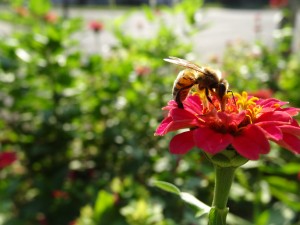 Last September, the ¬†Ninth Circuit Court of Appeals unequivocally rejected ¬†EPA‚Äôs registration of sulfoxaflor. The Court concluded that EPA violated federal law when it approved sulfoxaflor without reliable studies regarding the impact that the insecticide may ¬†have on honey bee colonies. The Court vacated EPA‚Äôs unconditional registration of the chemical, meaning that sulfoxaflor could no longer be used in the U.S. This decision was in response to a suit filed by beekeepers challenging EPA‚Äôs initial registration of sulfoxaflor, which cited the insecticide‚Äôs threat to bees and beekeeping. The case: ¬†Pollinator Stewardship Council, American Honey Producers Association, National Honey Bee Advisory Board, American Beekeeping Federation, Thomas Smith, Bret Adee, Jeff Anderson v. U.S. EPA ¬†(9th Circuit U.S. Court of Appeals,‚Ä̬ĮNo. 13-7234)
Last September, the ¬†Ninth Circuit Court of Appeals unequivocally rejected ¬†EPA‚Äôs registration of sulfoxaflor. The Court concluded that EPA violated federal law when it approved sulfoxaflor without reliable studies regarding the impact that the insecticide may ¬†have on honey bee colonies. The Court vacated EPA‚Äôs unconditional registration of the chemical, meaning that sulfoxaflor could no longer be used in the U.S. This decision was in response to a suit filed by beekeepers challenging EPA‚Äôs initial registration of sulfoxaflor, which cited the insecticide‚Äôs threat to bees and beekeeping. The case: ¬†Pollinator Stewardship Council, American Honey Producers Association, National Honey Bee Advisory Board, American Beekeeping Federation, Thomas Smith, Bret Adee, Jeff Anderson v. U.S. EPA ¬†(9th Circuit U.S. Court of Appeals,‚Ä̬ĮNo. 13-7234)
According to the court decision, EPA skirted its own regulations when it ignored risk concerns, even with reduced maximum application rates, which EPA has done before, despite prior reprimands from the Court. The judge ruled  that additional higher Tier (Tier II) bee data was needed to fully assess risks, which EPA did not have. Thus, the court vacated sulfoxaflor’s registration. However, EPA’s new amended registration is for fewer uses and according to EPA, the proposed restrictions reduce the risk to bees below EPA’s level of concern such that no additional data requirements are triggered.
Now, EPA is proposing an amended registration, which the agency claims will be ‚Äúvery protective of pollinators,‚ÄĚ to allow the chemical‚Äôs use on fewer crops than were allowed under sulfoxaflor‚Äôs initial registration. For crops that are attractive to bees, the agency will prohibit sulfoxaflor‚Äôs use before and during bloom, when EPA expects that bees will ¬†not be present. Additional measures are being proposed to reduce spray drift. EPA is also specifically requesting public input on other proposals: a buffer zone requirement for when there is blooming vegetation bordering the treated field; and the prohibition of ¬†tank mixing sulfoxaflor with other pesticides. EPA has stated that ¬†these ¬†restrictions will ‚Äúpractically eliminate exposure to bees on the field, which reduces the risk to bees below EPA‚Äôs level of concern such that no additional data requirements are triggered.‚ÄĚ
Despite these new proposed restrictions, sulfoxaflor will still be a danger to bees due to its systemic nature ¬†‚ÄĒan issue EPA continually ignores or underestimates, according to beekeepers and environmental advocates. Sulfoxaflor is similar to that of neonicotinoid pesticides ‚ÄĒit acts on the nicotinic acetylcholine receptor (nAChR) in insects, and like neonicotinoids, it is a ‚Äúsystemic‚ÄĚ insecticide, which means that when applied to plants, it is absorbed and distributed throughout the plant, including pollen, and nectar. ¬†Residues will remain in pollen and nectar, and even contaminated soil and water long after initial application, sometimes for months and years. Bees and other pollinators will continually be exposed, exacerbating the problems faced by an already tenuous honey bee industry and further decimate bee populations.
Tell EPA not to register another bee-toxic chemical. Comments are being accepted until June 17, 2016.
Honey bees and wild bees have been suffering elevated population declines over the last few years. A recent government-sponsored survey reports that U.S. beekeepers lost  44 percent of their honey bee colonies between April 2015 and April 2016, one of the highest recorded losses. There is a  growing scientific consensus   that systemic, persistent insecticides like neonicotinoids are a major contributing factor to declines in wild pollinators and honey bee colonies.  A recently published study by researchers at Purdue University  finds that honey bees collect most of their pollen from non-crop plants that are frequently contaminated with a wide range of pesticides. Numerous pesticides, including sulfoxaflor, neonicotinoids, pyrethroids, and fungicides are highly toxic to honey bees and have a range of effects including impacts on learning behavior, foraging, reproduction and queen production, as well as impairing bee immune systems making them more susceptible to parasites and disease.
In light of the ¬†shortcomings of federal action‚Ä̬Įto protect these beneficial ¬†organisms, ¬†pollinators need pesticide-free habitat ¬†throughout communities. ¬† You can also declare your garden, yard, park or other space as pesticide-free and pollinator friendly. It does not matter how large or small your pledge is, as long as you contribute to the creation of safe pollinator habitat.‚Ä̬ĮSign the pledge today! Need ideas on creating the perfect pollinator habitat? The‚Ä̬ĮBee Protective Habitat Guide‚Ä̬Įcan tell you which native plants are right for your region. For more information on what you can do, visit our ¬†BEE Protective ¬†page.
All unattributed positions and opinions in this piece are those of Beyond Pesticides.
Source: EPA News Release
Posted in Agriculture, Chemicals, National Politics, Pesticide Regulation, Pollinators, Sulfoxaflor, Take Action by: Beyond Pesticides
6 Comments
02
Jun
(Beyond Pesticides June 2, 2016) United States Department of Agriculture (USDA) Secretary Tom Vilsack recently released a Proclamation for National Pollinator Week, which is set to take place from June 20-26, 2016. National Pollinator Week began ten years ago when the U.S. Senate unanimously approved the designation of a week in June to address the urgent issue of declining pollinator populations. Pollinator week has since grown to be an international celebration of the valuable ecosystem services provided by bees, birds, butterflies, bats and all other pollinator species. While much remains to be done to combat contributing factors to pollinator declines, such as the use of neonicotinoid pesticides and disappearing pollinator habitat, National Pollinator Week is a chance to reflect and celebrate the achievements of the past year, while simultaneously raising awareness of the important role pollinators play in our daily lives.
 This year, to help increase education and bring awareness to the issue of pollinator declines, Beyond Pesticides and the Center for Food Safety are teaming up with several Washington, DC area restaurants to launch a ‚ÄúMade by Pollinators‚ÄĚ campaign. Participating ¬†restaurants, which include Founding Farmers, Lavagna, Tabard Inn and Restaurant Nora, will ¬†educate the public on the importance of pollinators in our daily lives by marking up their ¬†menus to show patrons how many of their favorite dishes contain ingredients that rely on pollinators ¬†for production. Currently, one out of every three bites of food we take requires pollination, a fact these environmentally conscious restaurants will impart on the public as they dine during National Pollinator Week 2016.
This year, to help increase education and bring awareness to the issue of pollinator declines, Beyond Pesticides and the Center for Food Safety are teaming up with several Washington, DC area restaurants to launch a ‚ÄúMade by Pollinators‚ÄĚ campaign. Participating ¬†restaurants, which include Founding Farmers, Lavagna, Tabard Inn and Restaurant Nora, will ¬†educate the public on the importance of pollinators in our daily lives by marking up their ¬†menus to show patrons how many of their favorite dishes contain ingredients that rely on pollinators ¬†for production. Currently, one out of every three bites of food we take requires pollination, a fact these environmentally conscious restaurants will impart on the public as they dine during National Pollinator Week 2016.
To support the ‚ÄúMade by Pollinators‚ÄĚ campaign, we encourage anyone in the greater Washington, DC area to make a reservation at one of these fine establishments during National Pollinator Week 2016. For information on how to do so, please see below. Additionally, if you know of a restaurant in your area that may wish to participate in the ‚ÄúMade by Pollinators‚ÄĚ campaign, click here to read our flyer on how to get involved.
MAKE A RESERVATION at one of our participating restaurants to celebrate National Pollinator Week!
In addition to the ‚ÄúMade by Pollinators‚ÄĚ campaign, Beyond Pesticides is also supporting the national Keep the Hives Alive Tour, which will culminate in Washington, DC during National Pollinator Week. The Keep the Hives Alive Tour aims to educate the general public on the impact bee-toxic chemicals have on the livelihoods of American beekeepers. The tour will travel across the United States, holding rallies and events to raise awareness about pollinator declines, and urge action on bee-toxic pesticides to safe guard our food supply. If you would like to contribute to the Keep the Hives Alive Tour or find out how to get involved, please visit the Indiegogo campaign page.
Finally, Beyond Pesticides will be participating in USDA’s seventh annual Pollinator Festival on Friday, June 24 from 10 a.m. to 2 p.m. The festival, which is held outside USDA Headquarters next to the Headquarters People Garden and USDA Farmers Market along 12st street SW, in Washington, DC. Beyond Pesticides will be distributing clover and other pollinator friendly seeds, as well as sharing information about the organization’s efforts to protect pollinators, so be sure to stop by if you are in the area.
For more information on how to help pollinators in your area, visit our BEE Protective page. Bee Protective  is a national campaign established by Beyond Pesticides and Center for Food Safety, and works with municipalities, campuses, and homeowners to adopt policies that protect pollinators from bee-toxic pesticides. You can also help fight pollinator declines by signing our petition to tell the Environmental Protection Agency to ACT NOW on bee killing pesticides. Click here to add your name before June 22nd!
All unattributed positions and opinions in this piece are those of Beyond Pesticides.
Source: National Pollinator Week Proclamation
Posted in Announcements, National Politics, Pollinators, State/Local, Take Action, Washington D.C. by: Beyond Pesticides
No Comments
01
Jun
(Beyond Pesticides, June 1, 2016) A study  by researchers at Purdue University has concluded  that honey bees collect most of their pollen from non-crop plants that are frequently contaminated with agricultural and urban pesticides. The researchers found this to be true even in places where croplands dominate the area.  The study, which detected neonicotinoids, pyrethroids, fungicides, and others, highlights the large number of toxic pesticides to which bees are exposed to in the environment.
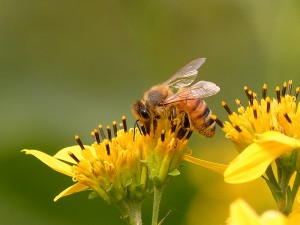 Researchers collected pollen from Indiana honey bee hives at three sites over 16 weeks. The hives were placed in a variety of settings, such as an open meadow with wildflowers, woody shrubs and trees present (non-agricultural), the border of a corn field that was treated with the neonicotinoid clothianidin and three fungicides, and the border of a non-treated corn field. The pollen samples that were collected by the bees represented up to 30 plant families and contained residues from pesticides spanning nine chemical classes. The researchers found 29 pesticides in pollen from the meadow site, 29 pesticides in pollen from the treated cornfield, and 31 pesticides in pollen from the untreated cornfield. The most common chemical products found in pollen from each site were fungicides and herbicides, typical crop disease and weed management products. Of the insecticides that were found, in addition to neonicotinoids, the highest concentrations in the bee pollen were pyrethroids, typically used to control mosquitoes.
Researchers collected pollen from Indiana honey bee hives at three sites over 16 weeks. The hives were placed in a variety of settings, such as an open meadow with wildflowers, woody shrubs and trees present (non-agricultural), the border of a corn field that was treated with the neonicotinoid clothianidin and three fungicides, and the border of a non-treated corn field. The pollen samples that were collected by the bees represented up to 30 plant families and contained residues from pesticides spanning nine chemical classes. The researchers found 29 pesticides in pollen from the meadow site, 29 pesticides in pollen from the treated cornfield, and 31 pesticides in pollen from the untreated cornfield. The most common chemical products found in pollen from each site were fungicides and herbicides, typical crop disease and weed management products. Of the insecticides that were found, in addition to neonicotinoids, the highest concentrations in the bee pollen were pyrethroids, typically used to control mosquitoes.
“Although crop pollen was only a minor part of what they collected, bees in our study were exposed to a far wider range of chemicals than we expected,” said Christian Krupke, Ph.D., one of the researchers, in a press release. “The sheer numbers of pesticides we found in pollen samples were astonishing. Agricultural chemicals are only part of the problem. Homeowners and urban landscapes are big contributors, even when hives are directly adjacent to crop fields.” Pyrethroids, typically used near homes and gardens with many different kinds of flowering plants, where pollinators are likely to be found, may expose bees to higher levels of chemicals on a more frequent basis.
Pyrethroids, due to their toxicity to bees, are thought by some researchers to be a major contributor to the significant decline in bee populations after neonicotinoids. In fact, some scientists are finding that honey bees’ olfactory receptor neurons, which are responsible for inter-individual communication, are affected by pyrethroid exposures. Studies find that sublethal concentrations of the pyrethroids can significantly reduce bee fecundity and decrease the rate at which bees develop to adulthood and reproduce. Several field and laboratory studies using pyrethroids have consistently documented decreases in foraging activity and activity at the hive entrance after exposure.
What Can You Do?
There are safer and more effective alternatives to pyrethroid-based mosquito control, given that these spray programs are of very limited efficacy. In a study published  in  the Journal of Agricultural and Environmental Ethics, former Cornell University professor of entomology David Pimentel, PhD calculated that less than .0001 percent of ultra low volume (ULV) pesticide sprays reach target insects. Further, along with vulnerable honey bees, people with compromised immune systems, chemically sensitized people, pregnant women, and children with respiratory problems, such as asthma, are particularly vulnerable to these pesticide spray programs and will suffer disproportionately from exposure.
Beyond Pesticides believes the ideal mosquito management strategy comes from an integrated approach that emphasizes education, aggressive removal of standing water sources, larval control, monitoring, and surveillance for both mosquito-borne illness and pesticide-related illness. Control of disease-carrying mosquitoes can be successful when emphasis is placed on public education and preventive strategies. Individuals can take action by eliminating standing water, introducing mosquito-eating fish, encouraging predators, such as bats, birds, dragonflies and frogs, and using least-toxic larvacides like bacillus thuringiensis israelensis (Bti). Community based programs should encourage residents to employ these effective techniques, focus on eliminating breeding sites on public lands, and promote monitoring and action levels in order to determine what, where, and when control measures might be needed. Through education of proper cultural controls, and least-toxic and cost effective biological alternatives, the use of hazardous  control methods, such as toxic pesticides, can be eliminated, and you can better protect pollinators such as honey bees.
Let’s BEE Protective and support a shift away from the use of these toxic chemicals by encouraging organic methods and sustainable land management practices in your home, campus, or community.
Source: Nature Communications, EurekAlert!
All unattributed positions and opinions in this piece are those of Beyond Pesticides.
Posted in Agriculture, Alternatives/Organics, Announcements, Chemicals, Increased Vulnerability to Diseases from Chemical Exposure, Integrated and Organic Pest Management, neonicotinoids, Persistence, Pesticide Drift, Pesticide Regulation, Pesticide Residues, Pollinators, Pyrethrin, Take Action by: Beyond Pesticides
3 Comments
31
May
(Beyond Pesticides May 31, 2016) Last week, the U.S. House of Representatives passed a revised version of the Toxic Substances Control Act (TSCA), marking the first time since 1976 Congress has taken steps to address the vast shortcomings of the law to protect human health and safety. Their revisions miss the mark, however, as the changes create the potential for new hurdles, delays, and restrictions on states’ ability to enact their own toxic chemical regulations. This is a dangerous development, expecially given the bipartisan recognition and acknowledgement of the need for TSCA reform. As the bill heads to the Senate, environmental advocates who believe in the preservation of state and local power to regulate toxics more stringently than the federal government must act to prevent its passage.
Public health advocates and environmentalists have argued for decades that the  19 76 Toxic Substances Control Act  is outdated and riddled with gaps that leave Americans exposed to harmful chemicals. Under current law, around 64,000 chemicals are not subject to environmental testing or regulation. In absence of federal reform over the past 40 years, many states, including Washington, Connecticut, New Hampshire, Minnesota, New York and Vermont, have stepped up to fill the void, taking actions such as setting exposure limits lower than federal levels and enacting bans on dangerous toxic products like lead-weighted wheels and flame retardant mattresses. If the TSCA revisions pass, state authority to act and protect beyond the federal scope would be undermined.
76 Toxic Substances Control Act  is outdated and riddled with gaps that leave Americans exposed to harmful chemicals. Under current law, around 64,000 chemicals are not subject to environmental testing or regulation. In absence of federal reform over the past 40 years, many states, including Washington, Connecticut, New Hampshire, Minnesota, New York and Vermont, have stepped up to fill the void, taking actions such as setting exposure limits lower than federal levels and enacting bans on dangerous toxic products like lead-weighted wheels and flame retardant mattresses. If the TSCA revisions pass, state authority to act and protect beyond the federal scope would be undermined.
Those who argue for federal preemption of state environmental or public health laws maintain that uniformity of law is necessary in commerce. The U.S. democracy, however, is based on the ability of states and local governments to adopt standards that respond to local and state concerns and conditions. Additionally, typically, states do not exceed federal standards unless there is a weakness in the public health or environmental protections. Throughout the history of pesticide regulation, federal government action from time-to-time has been preceded by state action. Pesticides, such as DDT, DBCB, chlordane, EDB, and others were first banned by states, followed by federal action. Similarly, states have adopted requirements for posting and notice, school integrated pest management, field reentry restrictions for farmworkers, and other standards that more stringent than  federal law. In fact, because federal pesticide and toxic laws have upheld the right of  states to exceed federal standards for pesticide use, stronger federal law has resulted over time. As a result, Beyond Pesticides has maintained that it is essential to uphold the basic principle that states and localities have the authority to adopt  more restrictive standards preempted by the federal government. The role of the federal government is too establish a regulatory floor, not a ceiling.
While the final bill looks better in some ways than where it started, it does not look good on one of the issues that matters most ‚ÄĒstate preemption. As written, the bill relies on the Environmental Protection Agency (EPA) to protect public health, an obligation they continually fall short on, while simultaneously making it more difficult for states to go above and beyond EPA standards. Meanwhile, extreme legislators and public figures, including presidential hopeful Donald Trump, have called for elimination of EPA, raising questions about ¬†the agency‚Äôs longevity as a regulatory entity able to protect citizens from the harms associated with toxic chemicals.
While TSCA is badly in need of an update, this is not an update that should be supported. This state preemption provision is an unprecedented intrusion states’ ability to protect residents and the environment. For those reasons, we urge you to call your Senator (phone numbers listed in the link below) and tell them to preserve the right of your state to protect the health and environment of its residents when EPA fails to regulate or regulate adequately toxic substances.
Contact your Senator!  
Source: Seattle Times
All unattributed positions and opinions in this piece are those of Beyond Pesticides.
Posted in Announcements, National Politics, Pesticide Regulation, Take Action by: Beyond Pesticides
No Comments
27
May
(Beyond Pesticides, May 27, 2016) ‚ÄĒ Thanks to the hard work and efforts of beekeepers, environmental groups, scientists, legislators and activists, Maryland is the first state to pass legislation through its General Assembly that restricts consumers from using neonicotinoids, a pollinator-toxic pesticide. Earlier this month, the state of Connecticut also passed far-reaching legislation aimed at protecting pollinator populations from these toxic chemicals.
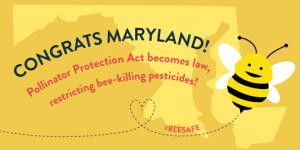 The Maryland Pollinator Protection Act (Senate Bill 198/House Bill 211) will become law without the Governor’s signature. Supporters had feared a veto from the executive office, but as a result of overwhelming pressure from beekeepers and activists, Governor Larry Hogan (R) allowed the bill to come into law. Under the Act, consumers will not be permitted to buy pesticides that contain neonicotinoids starting in 2018. Certified pesticide applicators, farmers and veterinarians will be still be allowed to use neonicotinoids.
The Maryland Pollinator Protection Act (Senate Bill 198/House Bill 211) will become law without the Governor’s signature. Supporters had feared a veto from the executive office, but as a result of overwhelming pressure from beekeepers and activists, Governor Larry Hogan (R) allowed the bill to come into law. Under the Act, consumers will not be permitted to buy pesticides that contain neonicotinoids starting in 2018. Certified pesticide applicators, farmers and veterinarians will be still be allowed to use neonicotinoids.
Connecticut’s bill also restricts consumer use of neonicotinoids. In addition, it requires the creation of pollinator habitat on state lands, and begins to address the use of these chemicals in agriculture by developing best practices on neonicotinoid coated seeds, and model pollinator habitat in farm preservation programs.
As Maryland‚Äôs bill made its way through the legislature, an amendment was attached to the Senate language, and later rejected, ¬†that implied legislative intent to preempt (take away) the authority of municipalities in Maryland to adopt local pesticide restrictions that are more restrictive than state policy on all property within their jurisdiction. The Senate language, which required a report and recommendation ‚Äúto ensure state laws and regulations are consistent‚ÄĚ with EPA, would have put the legislature on record, for the first time, as seeking to ensure preemption. Maryland is one of seven states that does not preempt local jurisdictions from adopting pesticide restrictions more stringent ¬†than the state.
Numerous studies confirm that neonics contribute to bee mortality, as well as to declines in native pollinators, including birds and butterflies. At the national level, beekeepers lost an average of 44% of their colonies over the past year. Losses for Maryland beekeepers have consistently been higher than national averages, with beekeepers losing upwards of 60% of their hives in 2015.
‚ÄúThis is a historic moment for our state that can be attributed to the hard work and dedication of many Maryland scientists, beekeepers, farmers, legislators as well as public health, food and environmental advocates,‚ÄĚ says Ruth Berlin, executive director of the Maryland Pesticide Education Network. ‚ÄúWe are excited that this important legislation will become law. This Act is necessary for our future food supply. We hope this motivates other states — and the federal government — to reduce the use of toxic neonic pesticides.‚ÄĚ
‚ÄúIf we‚Äôre going to have a healthy food system in this country, we need pollinators to thrive,‚ÄĚ said Jay Feldman, executive director of Beyond Pesticides. ‚ÄúWith the passage of the Pollinator Protection Act in Maryland, the Pollinator Health bill in Connecticut, states are sending a message to the White House, EPA, and Congress that the actions they‚Äôve taken to date are simply not enough.‚ÄĚ
For more information on the Maryland Pollinator Protection Act, see this fact sheet, or previous Beyond Pesticides’ Daily News stories. More information on the pollinator crisis can be found on the Bee Protective webpage.
All unattributed positions and opinions in this piece are those of Beyond Pesticides.
Posted in Uncategorized by: Beyond Pesticides
No Comments
27
May
(Beyond Pesticides, May 27, 2016) Oxitec, a self-described pioneer in using advanced genetics to control target  insects, has petitioned the U.S. Food and Drug Administration (FDA) to grant emergency approval of genetically engineered (GE) mosquitoes to fight the spread of the Zika virus. Oxitec has proposed a trial to determine the efficacy of their self-limiting mosquitoes for the control of Aedes aegypti, a type of mosquito known to transmit the Zika virus, in Key Haven, Monroe County, Florida. However, some in the environmental community are concerned about the possible non-target effects of releasing these genetically modified mosquitoes into nature and urge additional research in the lab.
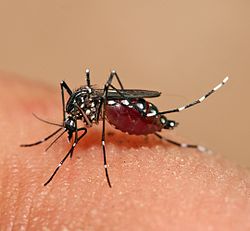 The plan for a release of these GE mosquitoes has been in the works for a while. In February 2015, it was reported that the Florida Keys Mosquito Control District (FKMCD) was working alongside Oxitec to release these GE mosquitoes, but, at the time, the plan had not yet been finalized. A change.org petition against the release garnered over 146,000 signatures and continues to grow, with numbers around 168,000 to this date. In February 2016, Oxitec submitted a draft environmental assessment to FDA, and a month later, FDA published a preliminary finding of no significant impact in support of the Key Haven field trial.  The public comment period for these two documents closed on May 13, with over 1,000 comments, and FDA is currently reviewing those comments and all other information that was submitted. Oxitec is not  currently  allowed to conduct field trials until the FDA has finished its review.
The plan for a release of these GE mosquitoes has been in the works for a while. In February 2015, it was reported that the Florida Keys Mosquito Control District (FKMCD) was working alongside Oxitec to release these GE mosquitoes, but, at the time, the plan had not yet been finalized. A change.org petition against the release garnered over 146,000 signatures and continues to grow, with numbers around 168,000 to this date. In February 2016, Oxitec submitted a draft environmental assessment to FDA, and a month later, FDA published a preliminary finding of no significant impact in support of the Key Haven field trial.  The public comment period for these two documents closed on May 13, with over 1,000 comments, and FDA is currently reviewing those comments and all other information that was submitted. Oxitec is not  currently  allowed to conduct field trials until the FDA has finished its review.
Oxitec has produced the GE line of Aedes aegypti with the intent of suppressing the population of that mosquito at the release site. Aedes aegypti is known to transmit  potentially debilitating human viral diseases, including  Zika, dengue, yellow fever, and chikungunya. With the exception of chikungunya in Florida and a 2005 outbreak of dengue in Texas, there have not been any local transmission of Zika and yellow fever in mainland U.S. Local transmission requires the existence  of diseased mosquitoes, as opposed to insect-borne diseases that are contracted while traveling abroad.
Open field trials of the GE mosquito have been conducted in certain places, such as Brazil. Experiments with Oxitec’s GE mosquitoes call for large numbers of modified males to be released in the wild to mate with female mosquitoes and produce offspring that are unable to develop. To create these autocidal male mosquitoes, the company uses the antibiotic tetracycline to act as a chemical switch, allowing the GE larvae to develop and survive in the lab, rather than die immediately as planned in the wild. Larvae are supposed to die in the wild due to an absence of tetracycline.
However, internal Oxitec documents discuss an experiment where 15% of insects in the lab survived because mosquitoes were fed off of chicken-based cat food that contained low levels of tetracycline even after it was heat-treated in attempts to remove traces of the antibiotic. Tetracycline is used in a variety of different settings, from agriculture to the control of human diseases, and ultimately makes its way into the environment. Studies show that most wastewater treatment plants are unable to effectively remove tetracycline antibiotics, and the compound is frequently detected in surface water, ground water, drinking water, wastewater, soils and sediment. Thus, low levels of tetracycline in the environment may result in only a temporary reduction in the numbers of disease carrying mosquitoes. And there are further questions regarding the impacts of how tetracycline-exposed survivor GE mosquitoes may impact human health or wildlife.
Speaking to USA Today, Peter Hotez, dean of the National School of Tropical Medicine at Baylor College of Medicine in Houston, said questions remain about the altered bugs. Oxitec has not yet shown that the mosquitoes reduce rates of diseases such as Zika. And, tests of insects were relatively small, meaning there’s no way to know whether the technology will be effective on a large scale, he added.
Alternatives and Public Education
Control of disease-carrying mosquitoes can be successful when emphasis is placed on public education and preventative strategies. Individuals can take action by eliminating standing water, introducing mosquito-eating fish, encouraging predators such as bats, birds, dragonflies and frogs, and using least-toxic larvacides like bacillus thuringiensis israelensis (Bti). Community based programs should encourage residents to employ these effective techniques, focus on eliminating breeding sites on public lands, and promote monitoring and action levels in order to determine what, where, and when control measures might be needed. New Jersey’s Cape May County provides an excellent example of a low-risk alternative to employing insecticides or introducing GE species. Cape May has used mosquitoes’ natural predators, tiny copepods, to eat the larvae of the mosquito. Through education of proper cultural controls, and least-toxic and cost effective biological alternatives, the use of risky technologies such as toxic pesticides and GE mosquitoes can be avoided.
For additional information and resources on least-toxic mosquito control alternatives, see Beyond Pesticides’ Mosquito Management program page.
Source: USA Today, U.S. Food and Drug Administration
All unattributed positions and opinions in this piece are those of Beyond Pesticides.
Posted in Announcements, Florida, Genetic Engineering, Mosquitoes, Pests, State/Local by: Beyond Pesticides
No Comments
26
May
(Beyond Pesticides, May 26, 2015) Maryland’s historic Pollinator Protection Act, (SB 198 and HB 211) may be in danger. Last month, lawmakers approved the bill by a 98-39 vote in the Maryland House of Delegates, however it faces the possibility of a veto by Governor Larry Hogan (R). While the governor’s office says that the bill is currently under review, according to local news source WBAL, the governor is prepared to veto the bill, which he has until tomorrow, Friday, May 27, to do. If the governor does veto the bill, Maryland’s Pollinator Protection Act will go back to the legislature for an override vote, which will take place in early 2017.
Meanwhile, beekeepers continue to lose their bees at unprecedented rates. Last week, we reported results of 2015-16 Colony Loss Survey, which show no sign that the crisis of abating. According to the survey, beekeepers lost 28.1% of their colonies over this past winter, and a total of 44% of their colonies over the last year. This marks the second year in a row that summer declines (28.1%) were on par with declines experienced during winter.
WBAL reports that the governor is likely to veto the bill because of the Maryland Department of Agriculture’s testimony submitted in opposition to the Pollinator Protection Act, which cites a lack of scientific evidence linking neonicotinoids to pollinator decline. However, there is an overwhelming amount of research demonstrating that neonicotinoids, such as imidacloprid, thiamethoxam and clothianidin working individually or synergistically, play a critical role in the ongoing decline of bees and other pollinators. Neonicotinoids affect the central nervous system of insects, resulting in paralysis and eventual death. These pesticides have consistently been implicated as a key contributor  in pollinator declines, not only through immediate bee deaths, but also through sublethal exposure that causes  changes in bee reproduction, navigation, and foraging. Pesticide exposure can impair both detoxification mechanisms and immune responses, rendering bees more susceptible to viruses, parasites, and other diseases, and leading to devastating bee losses.
The bill represents an important step by the Maryland legislature, since consumers in the state would be prohibited from using products containing neonicotinoid pesticides starting in 2018. However, the legislation’s  reach does not extend to farmers, veterinarians, and certified pesticide applicators, who will still be permitted to apply  the chemicals. Consumers can also buy treated plants and seedlings from stores without any labeling. Cumulatively, these present major sources of exposure for bees and other pollinators.
Shortly after Maryland’s Pollinator Protection Act was passed through the legislature, the Connecticut legislature unanimously passed a wide-ranging bill, Bill No. 231, An Act Concerning Pollinator Health to protect declining pollinator populations from neonics, which was signed into law by Governor Dannel P. Malloy earlier this month.
Numerous local communities, universities, and retailers have also taken steps to remove neonicotinoid pesticides from use. At the federal level, Congress has an opportunity to suspend the use of  neonics  until they have been proven not to result in unreasonable adverse effects on pollinators through the Saving America’s Pollinators Act.  While the White House has established a National Pollinator Health Strategy, it is evident that more will need to be done to address pesticide use in order to achieve President Obama’s goal of no more than 15% annual winter losses within the next decade. In a recent report, the Government Accountability Office concurred that the U.S. Environmental Protection Agency and Department of Agriculture are not doing enough to protect pollinators.
Proactive state and local steps to address the issue of pollinator decline is critical in the absence of federal action. Beyond Pesticides has long advocated a regulatory approach that prohibits toxic pesticide  use and requires alternative assessments. We suggest an approach that rejects uses and exposures deemed acceptable under risk assessment calculations, and instead focuses on safer alternatives that are proven effective, such as organic agriculture, which prohibits the use of neonicotinoids. See  Bee Protective  to learn  how you can help.
Take Action: If you are a Maryland resident, send a letter to Governor Hogan in support of The Pollinator Protection Act. Tell the Governor not to veto this important measure, because pollinators can’t wait.
Source: WBAL
All unattributed positions and opinions in this piece are those of Beyond Pesticides.
Posted in Announcements, Maryland, National Politics, Pesticide Regulation, Pesticide Residues, Pollinators, State/Local by: Beyond Pesticides
1 Comment
25
May
(Beyond Pesticides, May 25, 2016) New York City’s Prospect Park is bringing in a herd of goats to fight back opportunistic species that are encroaching in an area of the park after damage caused by Hurricane Sandy. Rather than spray toxic weed killers like 2,4-D, triclopyr, or glyphosate, the Prospect Park Alliance used the grant money it obtained from the National Park Service to bring in these 4-legged weed warriors as a safe and environmentally friendly way to restore storm-damaged areas. 
“We are pleased to welcome these goats to Prospect Park to help us further the important woodland restoration work that has always been a focus for the Alliance,” Prospect Park Alliance President Sue Donoghue said to ABC7. “These goats will provide an environmentally-friendly approach to our larger efforts, which will not only beautify the Park, but make it more resilient to future storms.”
After Hurricane Sandy barreled up the east coast, a roughly 1.5 acre area of Prospect Park was seriously damaged, with 100s of trees toppled. The disturbance has allowed so-called invasive species to move into the park, supplanting the regrowth of native species in the last remaining forested area in the borough of Brooklyn. Goats act as broad-spectrum weed killers; they will eat everything. In fact, goats are often more efficient at eradicating weeds, and are more environmentally sustainable than using harmful pesticides and chemicals. Once goats graze a weed it cannot go to seed because it has no flower and cannot photosynthesize to take in sunlight and build a root system because it has no leaves. Grasses are a last choice for goats, which means desirable grass species are left behind with natural fertilizer to repopulate the land. Goats are notorious for eating poisonous plants, such as poison ivy and poison oak, and can handle them without getting sick.
Prospect Park joins the long and growing list of places that have opted for goat-powered weed control over the use of toxic pesticides. The list ranges from D.C’s Congressional Cemetery, to Google’s Corporate Campus, Chicago O’Hare International Airport, and cities from Durango, CO, to Carrboro, NC, and Cheyenne, WY. In California, they have been used to prevent wildfires during the drought. Recent studies show their value in suppressing opportunistic weeds like phragmities.
Goats are perfect for areas where even mechanical controls are difficult to use. “This area’s steep hillsides present unique challenges and access issues for staff and machinery, but are easily accessible to goats-providing an environmentally friendly and highly efficient approach to weed removal,” said Christian Zimmerman, Prospect Park Alliance Vice President of Capital and Landscape Management to ABC7. “Once their work is complete, we will then plant new native trees and shrubs, including red and white oaks, spicebush and service berry, which will help bring back important habitat for birds and other wildlife.” Goats also provide a great attraction for kids and parents alike, who can watch the ruminant animals hard at work.
Beyond Pesticides has long been an advocate for the use of goats and grazing animals as a least-toxic, biological solution for weed management. To learn more, read ‚ÄúSuccessfully Controlling Noxious Weeds with Goats: The natural choice that manages weeds and builds soil health.‚ÄĚ Watch Beyond Pesticides‚Äô Board Member Lani Malmberg, a professional goat herder and owner of Ewe4ic Ecological Services, speak at the 33rd National Pesticide Conference along with other experts on the Organic Land Management and Cutting Edge Alternatives panel. For more information on natural, non-chemical land management strategies see Beyond Pesticides‚Äô Lawns and Landscapes and Invasive Weed Management pages.
All unattributed positions and opinions in this piece are those of Beyond Pesticides.
Posted in Announcements, Beneficials, Biological Control, Lawns/Landscapes, New York, State/Local by: Beyond Pesticides
No Comments
24
May
(Beyond Pesticides May 24, 2016) Nearly two years after the first legal retail sales of marijuana in Washington State, the state Liquor and Cannabis Board (LCB) finally took action to protect the rights of consumers by strengthening its ability to issue product recalls when there is a risk to health and safety. Under the new rules, businesses will be required to isolate and prevent the distribution of products that violate state pesticide regulations, and, in certain cases, may mandate that some products be destroyed under the LCB’s supervision. This action is the final codification of emergency rules that were passed by the state earlier this year to combat contaminated cannabis products. 
The move by Washington follows ¬†widespread cannabis recalls ¬†in the City of Denver, ¬†and actions from Colorado‚Äôs Governor ¬†to declare pesticide-tainted cannabis ‚Äúa threat to public safety.‚ÄĚ However, it is not all good news as the state also set allowable levels for unapproved pesticides on pot. Washington State currently lists ¬†over 200 ¬†pesticide products as permitted in cannabis production, despite their lack of compliance with federal and state testing requirements for the range of consumer, worker, and environmental exposures. Outside of that list, the state previously employed a ‚Äúzero tolerance‚ÄĚ policy for marijuana testing positive for any other pesticides. However, amid concerns of drift from neighboring food-crop farms, as well as alleged difficulties for labs to test for zero residue, the LCB set thresholds for unapproved pesticides that mirror levels adopted by Oregon. According to the new rules, anything testing below the threshold levels is considered safe, despite the lack of testing for increased exposure through inhalation, ingestion, and skin absorption of pesticide-treated marijuana.
Beyond Pesticides supports criteria that  limits allowed pesticides to those that are exempt from registration under federal pesticide law and also permitted for use in organic production, as has been done in New Hampshire. As outlined in a letter sent from Beyond Pesticides to Washington State Department of Agriculture (WSDA) officials, adhering exclusively to pesticides allowed  under 25(b) [Federal Insecticide, Fungicide and Rodenticide Act (FIFRA)] is the best way to avoid any legal ramifications for unregistered pesticide use, as well as protect  workers, consumers and the environment safe from the unstudied side effects that may result from the use of toxic pesticides on marijuana crops. With  this  approach, Beyond Pesticides urges growers to develop an organic system plan that encourages pest prevention, and eliminating pest-conducive conditions.  Implementing this approach, advocates say,  will ensure the sustained growth of cannabis production that protects public health and the environment.
Also concerning when it comes to the new Washington rules is the continued failure to require pesticide testing for all marijuana products. Instead, the state relies on spot inspections and complaints to determine whether a crop has been treated with illegal pesticides. Jason Zitzer, lab chief at Trace Analytics in Spokane, WA, showed his concern over the levels of illegal pesticides found in marijuana stating, ‚ÄúI know I have bias and it sounds self-serving given our testing capabilities in the market, but a very high percentage of samples we are testing are lighting up with residues way above the Oregon proposed action levels.‚ÄĚ This is troubling, as available data on ¬†pesticide exposure ¬†from ¬†residue in cannabis smoke ¬†raises serious health concerns. ¬†Those who use ¬†cannabis for medicinal purposes may ¬†have underlying health conditions that can be complicated or worsened by pesticide exposure. Implementing an emergency measure to allow state recalls is a step forward, but requires a strong enforcement mechanism and way of ensuring that even the most sensitive medicinal cannabis users are protected.
For more information and background on this important issue, see Beyond Pesticides’ report Pesticide Use in Marijuana Production: Safety Issues and Sustainable Options.
All unattributed positions and opinions in this piece are those of Beyond Pesticides.
Source: Seattle Times
Posted in Announcements, Cannabis, Chemicals, State/Local, Washington by: Beyond Pesticides
No Comments
23
May
(Beyond Pesticides, May 23, 2016) At the Breaking Through Power conference today, Beyond Pesticides’ executive director, Jay Feldman, will provide a retrospective on 35 years of Beyond Pesticides’ work and outline critical needs moving forward to protect health and the environment. This historic meeting of civic engagement across national social action organizations comes at a time when bee colonies have experienced sustained losses above 40% (44% 2015-16 and 42% 2014-15). Central to the ecosystem, pollinators are essential to the viability of one-third of the food supply.
 Meanwhile, with the surge in genetically engineered crops, pesticide use is increasing exponentially, as herbicide use increased 4 to 18% a year, depending on the crop, over the last decade, while weed and insect resistance is growing rapidly ‚ÄĒthreatening productivity. Twenty-four species of weeds in 29 states and worldwide now exhibit resistance to the most widely used herbicide, Roundup (glyphosate).
Meanwhile, with the surge in genetically engineered crops, pesticide use is increasing exponentially, as herbicide use increased 4 to 18% a year, depending on the crop, over the last decade, while weed and insect resistance is growing rapidly ‚ÄĒthreatening productivity. Twenty-four species of weeds in 29 states and worldwide now exhibit resistance to the most widely used herbicide, Roundup (glyphosate).
Advocates say that pesticide impacts on clean air, water, and food continue to be ignored by the chemical industry and a slow moving Environmental Protection Agency. Meanwhile, communities across the country are adopting local laws and policies that restrict pesticide use, and two states, Maryland and Massachusetts, have passed bills that ban retail sale of the neonicotinoid pesticides linked to pollinator decline.
Beyond Pesticides points to certified organic agriculture as the answer to the pesticide treadmill of increasing use of toxic pesticides harmful to people, pollinators, biodiversity and a sustainable environment.
When: May 23-26, 2016.
Where: DAR Constitution Hall, 1776 D Street NW, Washington, D.C. 20006 (near 17th and C St NW).
Mr. Feldman will be presenting at 4:15pm on Monday, May 23, 2016. For full schedule, click here.
Additionally, the event will be live streamed at http://therealnews.com.
###
Posted in Announcements by: Beyond Pesticides
No Comments
20
May
(Beyond Pesticides, May 20, 2016) With Monsanto’s ¬†earnings forecast cut and shares down 19%, Bayer AG has made a takeover bid for ¬†the company, worth $42 billion, in an attempt to swallow the global seed producer and become the world‚Äôs biggest farm chemical supplier. Although the terms of the proposal have not yet been disclosed, Bayer confirmed the bid to Bloomberg News, and Monsanto said it is reviewing the offer. If the offer is accepted, it could be the biggest acquisition globally in 2016, and the largest German deal ever, according to Bloomberg data analysis. Bayer is known for a wide range of products, from aspirin and birth control to flea and tick collars and insecticides. Monsanto is the creator of the widely used and controversial herbicide formulation Roundup, which has glyphosate as its active ingredient.
 In order to finance the takeover, Bayer may consider selling off its stakes in its animal health business and plastics/foam chemicals business (Covestro AG), worth an estimated $6 billion and $5.5 billion, respectively. The takeover would solidify both companies in certain ways; Monsanto would strengthen Bayer’s seed business, while a deal with Bayer would help reduce Monsanto’s reliance on the agricultural industry.
In order to finance the takeover, Bayer may consider selling off its stakes in its animal health business and plastics/foam chemicals business (Covestro AG), worth an estimated $6 billion and $5.5 billion, respectively. The takeover would solidify both companies in certain ways; Monsanto would strengthen Bayer’s seed business, while a deal with Bayer would help reduce Monsanto’s reliance on the agricultural industry.
There has been a flurry of activity and mergers  in the big agricultural and chemical industries lately. In December 2015, chemical giants DuPont and Dow Chemical Companies announced that their boards of directors unanimously approved a merger of their companies through an all-stock deal, valuing the combined market capitalization at $130 billion. Then, in February 2016, China National Chemical Corp. acquired Syngenta AG, months after a failed attempt by Monsanto to takeover Syngenta. Many of these big agricultural and chemical companies have been struggling to cope with falling demand for farm chemicals due to falling crop prices and a strong dollar, and may believe that a merger will provide longer-term security.
However, for the billion-dollar agrochemical industry, a merger is likely to only provide short-term stability, increase the wealth of top executives, and raise the cost of food, as the new corporation will create a near monopoly that ¬†will allow it ¬†to increase prices. In the long-term, the market will reveal that relying on the promotion of chemical-intensive agricultural practices is not a sustainable business practice. Chemical-intensive (or conventional) ¬†agriculture depends on chemical fertilizers and toxic pesticides that have been shown to reduce soil organic matter and decrease the diversity of soil biota. These chemical inputs contaminate waterways leading to eutrophication and ‚Äúdead zones,‚ÄĚ where nothing is able to live or grow. Eventually, as chemical intensive agriculture depletes organic matter in the soil and there is nothing left with which to grow food or sustain life, chemical inputs will become obsolete. Sustainability advocates say that the ¬†only way that the agricultural industry can create a sustainable business model is to produce products that are compatible with ¬†organic agriculture.
While some argue that organic is too expensive, the simple fact is that chemical companies are able to externalize the social cost of their products in the form of eutrophication, soil erosion, harm to wildlife, healthcare costs to consumers, and numerous other adverse effects. Some researchers calculate the adverse impacts to health and the environment to be as much as $16.9 billion a year (Tegtmeier and Duffy 2004). If consumers paid the true cost of conventional food production, prices for conventionally grown goods would certainly be more expensive than organic products, which are certified through a process that protects human health and the environment.
Good organic practices work to build the soil and maintain an ecological balance that makes chemical fertilizers and synthetic pesticides obsolete. Claims that organic agriculture cannot feed the world because of lower yields are contested by scientific studies showing that organic yields are comparable to conventional yields and require significantly lower inputs. Organic agriculture advocates say that it is not only necessary in order to eliminate the use of toxic chemicals, but to ensure the long-term sustainability of food production.
For further information, check out our webpages on Organic Agriculture.
Source: Bloomburg News
All unattributed positions and opinions in this piece are those of Beyond Pesticides.
Posted in Agriculture, Announcements, Bayer, Corporations, Monsanto by: Beyond Pesticides
No Comments
19
May
(Beyond Pesticides, May 19, 2016) Using fear without facts, Congress is yet again attempting to gut Clean Water Act (CWA) provisions that protect waterways and communities from excessive pesticide pollution. In a move that was blasted by House Democrats this week, HR 897  (which was introduced as the Reducing Regulatory Burdens Act of 2015) was renamed the  Zika Vector Control Act, despite the fact that the bill does not actually do anything to address the threat of Zika. The legislation was defeated Tuesday on a suspension vote, 262-159, however the bill will be going to the Rules Committee on Monday, with anticipated House floor activity on Tuesday, May 24. (Take action: urge your representative to oppose HR 897.)
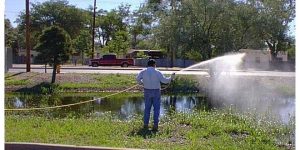 ‚ÄúIn a brazenly political act, the Republican leadership is trying to mask gutting the Clean Water Act as having something to do with fighting Zika,‚ÄĚ Drew Hammill, spokesman for House Minority Leader Nancy Pelosi (D-CA), said in a statement to The Hill. ‚ÄúThis bill has nothing to do with Zika and everything to do with Republicans‚Äô relentless special interest attacks on the Clean Water Act,‚ÄĚ he said. ‚ÄúIt will do nothing to stem the growing threat of the Zika virus.‚ÄĚ
‚ÄúIn a brazenly political act, the Republican leadership is trying to mask gutting the Clean Water Act as having something to do with fighting Zika,‚ÄĚ Drew Hammill, spokesman for House Minority Leader Nancy Pelosi (D-CA), said in a statement to The Hill. ‚ÄúThis bill has nothing to do with Zika and everything to do with Republicans‚Äô relentless special interest attacks on the Clean Water Act,‚ÄĚ he said. ‚ÄúIt will do nothing to stem the growing threat of the Zika virus.‚ÄĚ
The bill reverses a 2009 federal court decision in National Cotton Council v. EPA that directed EPA to require permits from applicators who spray over ‚Äúnavigable waters,‚ÄĚ as outlined in the CWA. It also follows years of failed attempts to repeal the Pesticide General Permit and allow pesticides to be discharged into bodies of water without federal oversight, as the Federal Insecticide, Fungicide, and Rodenticide Act (FIFRA) does not require tracking of such applications.
Under this legislation, pesticide applicators will  be able to discharge pesticides into waterways with no EPA oversight under the standards of the CWA and the permitting process, which takes into account local conditions that are not addressed under FIFRA. Furthermore, permits do not prevent applicators from using pesticides, especially for public health emergencies. The permits do require basic protections for water quality and aquatic wildlife. Applicators must simply record their pesticide applications and monitor application sites for any adverse incidents, which must be reported.
The reality is that including a CWA permitting process encourages pesticide users to seek alternative approaches to pest management if their current methods are going to contaminate nearby sources of water. Such a provision is not duplicative or burdensome, but simply an example of good governance.
‚ÄúIn past Congresses, my colleagues on the other side of the aisle have used the public health emergency de jour as rationale to pass and enact this legislation into law. At one time, West Nile Virus, the next western wildland fire suppression, and last Congress it was the drought,‚ÄĚ said U.S. Representative Donna Edwards (D-MD) in a statement. ‚ÄúNow, in nothing less than a purely political move, Republicans are considering this bill on suspension, but under the guise of combatting the spread of Zika.‚ÄĚ
Meaningful Action to Curb Zika
The Zika Vector Control Act does not include any language that would actually help stem mosquito populations. The only thing that has changed since it was known as the Reducing Regulatory Burdens Act is the title. Proponents of the legislation are essentially arguing that successful control of the Zika virus is contingent upon on a community’s ability to spray pesticides without having to apply for a permit if there is concern for contaminating nearby water. However, the efficacy of adulticidal pesticide applications (aerial or ground spraying) has been called into question over the years. This is usually the least efficient mosquito control technique, as it only targets adult mosquitoes that are present at the time of application. Further, the drifting spray impacts other non-target organisms like pollinators, birds, fish and amphibians.
Most experts agree that whether it’s Zika, Chikengunya or West Nile Virus, combating mosquito-borne infections should include good surveillance and scientific understanding for controlling mosquito populations. An efficient mosquito management strategy emphasizes public awareness, prevention, and monitoring methods. However, if these methods are not used properly, in time, or are ineffective, communities must determine if they should risk exposing vulnerable populations to potentially harmful diseases caused by mosquitoes or to chronic or deadly illnesses caused by pesticides. Commonly used mosquito pesticides like permethrin, resmethrin, naled and malation are all associated with some measure of human and ecological health risks, especially among people with compromised immune systems, chemically sensitized people, pregnant women, and children with respiratory problems, such as asthma.
Beyond Pesticides’ ideal  mosquito management strategy  comes from an integrated approach that emphasizes education, aggressive removal of standing water (which are breeding areas), larval control, monitoring, and surveillance for both mosquito-borne illness and pesticide-related illness. Control of disease-carrying mosquitoes can be successful when emphasis is placed on public education and preventive strategies.
Individuals can take action by eliminating standing water, introducing mosquito-eating fish, encouraging predators, such as bats, birds, dragonflies and frogs, and using least-toxic larvacides like  bacillus thuringiensis israelensis  (Bti). Community based programs should encourage residents to employ these effective techniques, focus on eliminating breeding sites on public lands, and promote monitoring and action levels in order to determine what, where, and when control measures might be needed. Through education of proper cultural controls, and least-toxic and cost effective biological alternatives, the use of hazardous  control methods, such as toxic pesticides, can be eliminated.
Take Action:
- Send a letter to your U.S. Representative urging opposition to  HR 897 and support of the Clean Water Act. Tell your Rep.  not to give in to fear: the Zika Vector Control Act, despite the misleading name, will not protect against Zika virus, but instead will allow for would eliminate safeguards that protect our waterways and communities from excessive pesticide pollution.
- Learn More About Mosquito Management: Arm yourself with knowledge about safe and effective management programs by checking out Beyond Pesticides’ Mosquito Management program page, which lists resources that can help you and your community safely manage mosquitoes, including least-toxic mosquito repellents, bed nets, and proper clothing that can be used to keep mosquitoes safely at bay.
Source: The Hill
All unattributed positions and opinions in this piece are those of Beyond Pesticides.
Posted in Announcements, Mosquitoes, National Politics, Pests, Take Action by: Beyond Pesticides
No Comments






















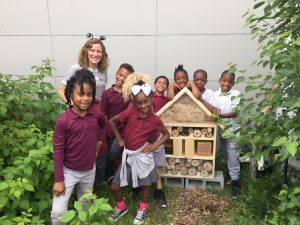


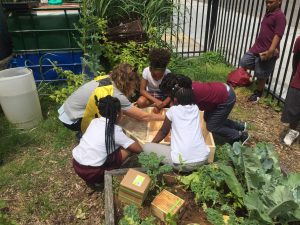

 The investigation, Buzz Kill: How the Pesticide Industry is Clipping the Wings of Bee Protection Efforts Across the U.S., reveals an array of pesticide industry tactics to slow urgently needed pollinator protection measures at federal and state levels. The report details how new state pollinator protection plans, many still unfinished, have been heavily influenced by pesticide industry interests. According to the report, industry is spending hundreds of thousands of dollars on lobbying to delay state and federal action on the chemicals they manufacture. As a result, state pollinator protection plans across the U.S. are falling short in several ways, including:
The investigation, Buzz Kill: How the Pesticide Industry is Clipping the Wings of Bee Protection Efforts Across the U.S., reveals an array of pesticide industry tactics to slow urgently needed pollinator protection measures at federal and state levels. The report details how new state pollinator protection plans, many still unfinished, have been heavily influenced by pesticide industry interests. According to the report, industry is spending hundreds of thousands of dollars on lobbying to delay state and federal action on the chemicals they manufacture. As a result, state pollinator protection plans across the U.S. are falling short in several ways, including: ‚ÄúThis research systematically investigates the economic impacts of organic agriculture,‚ÄĚ noted Dr. Jaenicke. ‚ÄúIts important findings show that organic contributes to the economic health of local economies. The growing market interest in organic agriculture can be leveraged into effective policy for economic development.‚ÄĚ
‚ÄúThis research systematically investigates the economic impacts of organic agriculture,‚ÄĚ noted Dr. Jaenicke. ‚ÄúIts important findings show that organic contributes to the economic health of local economies. The growing market interest in organic agriculture can be leveraged into effective policy for economic development.‚ÄĚ Through a review of scientific literature and publicly available biomonitoring studies, EWG compiled a comprehensive inventory of known or likely carcinogens that have been measured in people. According to the EWG report, data from the National Health and Nutrition Survey, or NHANES, conducted annually by the Centers for Disease Control and Prevention, confirms that many of these carcinogens are in the bodies of Americans not at risk of occupational exposure ‚ÄĒ indeed, at any given time some people may harbor dozens or hundreds of cancer-causing chemicals. Over half of the people tested had levels of arsenic and acrylamide in their bodies high enough to give them a more than 1 in 10,000 risk of cancer. Arsenic is used in certain pesticides, and acrylamide is sometimes found in food packaging and certain foods ‚ÄĚ‚ÄĚpotato chips and French fries have been found to have higher-than-average amounts of it. Other commonly found chemicals included benzene, found in petroleum, and DDT and DDE pesticides.
Through a review of scientific literature and publicly available biomonitoring studies, EWG compiled a comprehensive inventory of known or likely carcinogens that have been measured in people. According to the EWG report, data from the National Health and Nutrition Survey, or NHANES, conducted annually by the Centers for Disease Control and Prevention, confirms that many of these carcinogens are in the bodies of Americans not at risk of occupational exposure ‚ÄĒ indeed, at any given time some people may harbor dozens or hundreds of cancer-causing chemicals. Over half of the people tested had levels of arsenic and acrylamide in their bodies high enough to give them a more than 1 in 10,000 risk of cancer. Arsenic is used in certain pesticides, and acrylamide is sometimes found in food packaging and certain foods ‚ÄĚ‚ÄĚpotato chips and French fries have been found to have higher-than-average amounts of it. Other commonly found chemicals included benzene, found in petroleum, and DDT and DDE pesticides. Honey bees alone pollinate 95 kinds of fruits, nuts and vegetables, such as apples, avocados, almonds, and cranberries. The value of pollination services to U.S. agriculture alone amounts to nearly $30 billion and about 80% of flowering plants require animal pollination.
Honey bees alone pollinate 95 kinds of fruits, nuts and vegetables, such as apples, avocados, almonds, and cranberries. The value of pollination services to U.S. agriculture alone amounts to nearly $30 billion and about 80% of flowering plants require animal pollination. U.S. District Judge William Orrick stated in his ruling,‚ÄúThe EPA has no mandatory duty to require disclosure of ‚Äúinert‚ÄĚ ingredients in pesticides, even if those ingredients qualify as hazardous chemicals under separate statutes.‚ÄĚ Advocates have said for decades that people and communities cannot make informed decisions on pesticide products without full disclosure of all product ingredients and that the stated proprietary interests of chemical manufacturers is bogus, given the burgeoning market of pesticide products exempt from registration under the Federal Insecticide, Fungicide and Rodenticide Act (FIFRA) 25(b) provision, which are required to disclose all ingredients.
U.S. District Judge William Orrick stated in his ruling,‚ÄúThe EPA has no mandatory duty to require disclosure of ‚Äúinert‚ÄĚ ingredients in pesticides, even if those ingredients qualify as hazardous chemicals under separate statutes.‚ÄĚ Advocates have said for decades that people and communities cannot make informed decisions on pesticide products without full disclosure of all product ingredients and that the stated proprietary interests of chemical manufacturers is bogus, given the burgeoning market of pesticide products exempt from registration under the Federal Insecticide, Fungicide and Rodenticide Act (FIFRA) 25(b) provision, which are required to disclose all ingredients. After a proposal to renew the license for glyphosate for up to 15 years failed to win support
After a proposal to renew the license for glyphosate for up to 15 years failed to win support  Under  
Under   Last week, EPA released its triazine ecological risk assessments for
Last week, EPA released its triazine ecological risk assessments for  According to the report, diversified agroecology focuses on maintaining multiple sources of food production, and farming by applying ecological concepts and principles to the design and management of food systems. Industrial agriculture, on the other hand, requires highly-specialized production of a single food crop, and, through scale and task separation, focuses on increasing productivity through intensification. While monocultures and concentrated animal feeding operations (CAFOs) are characteristic of industrial agriculture, agroecological practices embrace spatial and temporal diversification (through practices like crop rotation and intercropping), and focus on multiple outputs.
According to the report, diversified agroecology focuses on maintaining multiple sources of food production, and farming by applying ecological concepts and principles to the design and management of food systems. Industrial agriculture, on the other hand, requires highly-specialized production of a single food crop, and, through scale and task separation, focuses on increasing productivity through intensification. While monocultures and concentrated animal feeding operations (CAFOs) are characteristic of industrial agriculture, agroecological practices embrace spatial and temporal diversification (through practices like crop rotation and intercropping), and focus on multiple outputs. In 2008, EPA granted Bayer a ‚Äúconditional‚ÄĚ registration for flubendiamide, a classification that allows a new pesticide to be registered and used in the field, despite outstanding data points on its toxicological impact. In this case, original data submitted to EPA by Bayer showed concern over the effect of the chemical and its breakdown product on
In 2008, EPA granted Bayer a ‚Äúconditional‚ÄĚ registration for flubendiamide, a classification that allows a new pesticide to be registered and used in the field, despite outstanding data points on its toxicological impact. In this case, original data submitted to EPA by Bayer showed concern over the effect of the chemical and its breakdown product on  Last September, the ¬†
Last September, the ¬† This year, to help increase education and bring awareness to the issue of pollinator declines, Beyond Pesticides and the Center for Food Safety are teaming up with several Washington, DC area restaurants to launch a ‚ÄúMade by Pollinators‚ÄĚ campaign. Participating ¬†restaurants, which include Founding Farmers, Lavagna, Tabard Inn and Restaurant Nora, will ¬†educate the public on the importance of pollinators in our daily lives by marking up their ¬†menus to show patrons how many of their favorite dishes contain ingredients that rely on pollinators ¬†for production. Currently, one out of every three bites of food we take requires pollination, a fact these environmentally conscious restaurants will impart on the public as they dine during National Pollinator Week 2016.
This year, to help increase education and bring awareness to the issue of pollinator declines, Beyond Pesticides and the Center for Food Safety are teaming up with several Washington, DC area restaurants to launch a ‚ÄúMade by Pollinators‚ÄĚ campaign. Participating ¬†restaurants, which include Founding Farmers, Lavagna, Tabard Inn and Restaurant Nora, will ¬†educate the public on the importance of pollinators in our daily lives by marking up their ¬†menus to show patrons how many of their favorite dishes contain ingredients that rely on pollinators ¬†for production. Currently, one out of every three bites of food we take requires pollination, a fact these environmentally conscious restaurants will impart on the public as they dine during National Pollinator Week 2016. Researchers collected pollen from Indiana honey bee hives at three sites over 16 weeks. The hives were placed in a variety of settings, such as an open meadow with wildflowers, woody shrubs and trees present (non-agricultural), the border of a corn field that was treated with the neonicotinoid clothianidin and three fungicides, and the border of a non-treated corn field. The pollen samples that were collected by the bees represented up to 30 plant families and contained residues from pesticides spanning nine chemical classes. The researchers found 29 pesticides in pollen from the meadow site, 29 pesticides in pollen from the treated cornfield, and 31 pesticides in pollen from the untreated cornfield. The most common chemical products found in pollen from each site were fungicides and herbicides, typical crop disease and weed management products. Of the insecticides that were found, in addition to neonicotinoids, the highest concentrations in the bee pollen were pyrethroids, typically used to control mosquitoes.
Researchers collected pollen from Indiana honey bee hives at three sites over 16 weeks. The hives were placed in a variety of settings, such as an open meadow with wildflowers, woody shrubs and trees present (non-agricultural), the border of a corn field that was treated with the neonicotinoid clothianidin and three fungicides, and the border of a non-treated corn field. The pollen samples that were collected by the bees represented up to 30 plant families and contained residues from pesticides spanning nine chemical classes. The researchers found 29 pesticides in pollen from the meadow site, 29 pesticides in pollen from the treated cornfield, and 31 pesticides in pollen from the untreated cornfield. The most common chemical products found in pollen from each site were fungicides and herbicides, typical crop disease and weed management products. Of the insecticides that were found, in addition to neonicotinoids, the highest concentrations in the bee pollen were pyrethroids, typically used to control mosquitoes. 76 Toxic Substances Control Act
76 Toxic Substances Control Act The
The  The plan for a release of these GE mosquitoes has been in the works for a while. In February 2015,
The plan for a release of these GE mosquitoes has been in the works for a while. In February 2015, 

 Meanwhile, with the surge in genetically engineered crops, pesticide use is increasing exponentially, as herbicide use increased 4 to 18% a year, depending on the crop, over the last decade, while weed and insect resistance is growing rapidly ‚ÄĒthreatening productivity. Twenty-four species of weeds in 29 states and worldwide now exhibit resistance to the most widely used herbicide, Roundup (glyphosate).
Meanwhile, with the surge in genetically engineered crops, pesticide use is increasing exponentially, as herbicide use increased 4 to 18% a year, depending on the crop, over the last decade, while weed and insect resistance is growing rapidly ‚ÄĒthreatening productivity. Twenty-four species of weeds in 29 states and worldwide now exhibit resistance to the most widely used herbicide, Roundup (glyphosate). ‚ÄúIn a brazenly political act, the Republican leadership is trying to mask gutting the Clean Water Act as having something to do with fighting Zika,‚ÄĚ Drew Hammill, spokesman for House Minority Leader Nancy Pelosi (D-CA), said in a statement to
‚ÄúIn a brazenly political act, the Republican leadership is trying to mask gutting the Clean Water Act as having something to do with fighting Zika,‚ÄĚ Drew Hammill, spokesman for House Minority Leader Nancy Pelosi (D-CA), said in a statement to 
